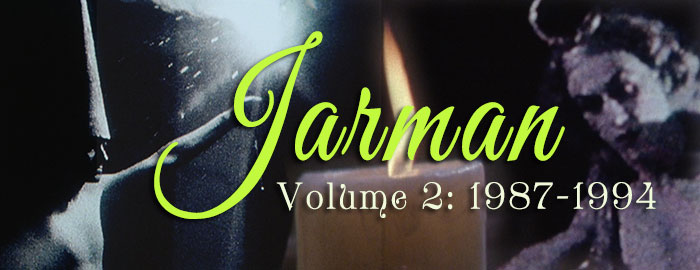

THE LAST OF ENGLAND
Color, 1987, 91 mins. 24 secs.
Directed by Derek Jarman
Starring Tilda Swinton, Nigel Terry, Jonny Phillips, "Spring" Mark Adley, Spencer Leigh
BFI (Blu-ray) (UK RB HD), Kino Lorber (Blu-Ray & DVD) (US RA/R1 HD/NTSC), Second Sight (UK R2 PAL), Umbrella (Australia R0 PAL) / WS (1.66:1) (16:9), Image Entertainment (DVD) (US R1 NTSC) / WS (1.78:1) (16:9)
WAR REQUIEM
Color, 1989, 92 mins. 36 secs.
Directed by Derek Jarman
Starring Nathaniel Parker, Tilda Swinton, Laurence Olivier, Patricia Hayes, Nigel Terry
BFI (Blu-ray) (UK RB HD), Kino Lorber (DVD) (US R1 NTSC) / WS (1.78:1) (16:9)
THE GARDEN
Color, 1990, 92 mins. 8 secs..
Directed by Derek Jarman
Starring Tilda Swinton, Johnny Mills, Philip MacDonald, Peter Lee-Wilson, Spencer Leigh
BFI (Blu-ray) (UK RB HD), Artificial Eye (DVD) (UK R2 PAL)
EDWARD II
Color, 1991, 90 mins. 10 secs.
Directed by Derek Jarman
Starring Steven Waddington, Andrew Tiernan, Tilda Swinton, John Lynch, Dudley Sutton, Nigel Terry
BFI (Blu-ray) (UK RB HD), Film Movement (Blu-ray) (US RA HD), Second Sight (DVD) (UK R2 PAL), Image Entertainment (DVD) (US R1 NTSC) / WS (1.66:1) (16:9)
WITTGENSTEIN
Color, 1993, 71 mins. 54 secs.
Directed by Derek Jarman
Starring Derek Jarman Starring Clancy Chassay, Karl Johnson, Nabil Shaban, Michael Gough, Tilda Swinton
BFI (Blu-ray & DVD) (UK RB/R2 HD/PAL), Zeitgeist (DVD) (US R1 NTSC) / WS (1.66:1) (16:9)
BLUE
Color, 1993, 75 mins. 51 secs.
Directed by Derek Jarman
BFI (Blu-ray & DVD) (UK RB HD), Zeitgeist (DVD) (US R1 NTSC) / WS (1.78:1) (16:9)
GLITTERBUG
Color,
1994, 55 mins. 59 secs.
Directed by Derek Jarman
BFI (Blu-ray & DVD) (UK RB HD), Zeitgeist (DVD) (US R1 NTSC)
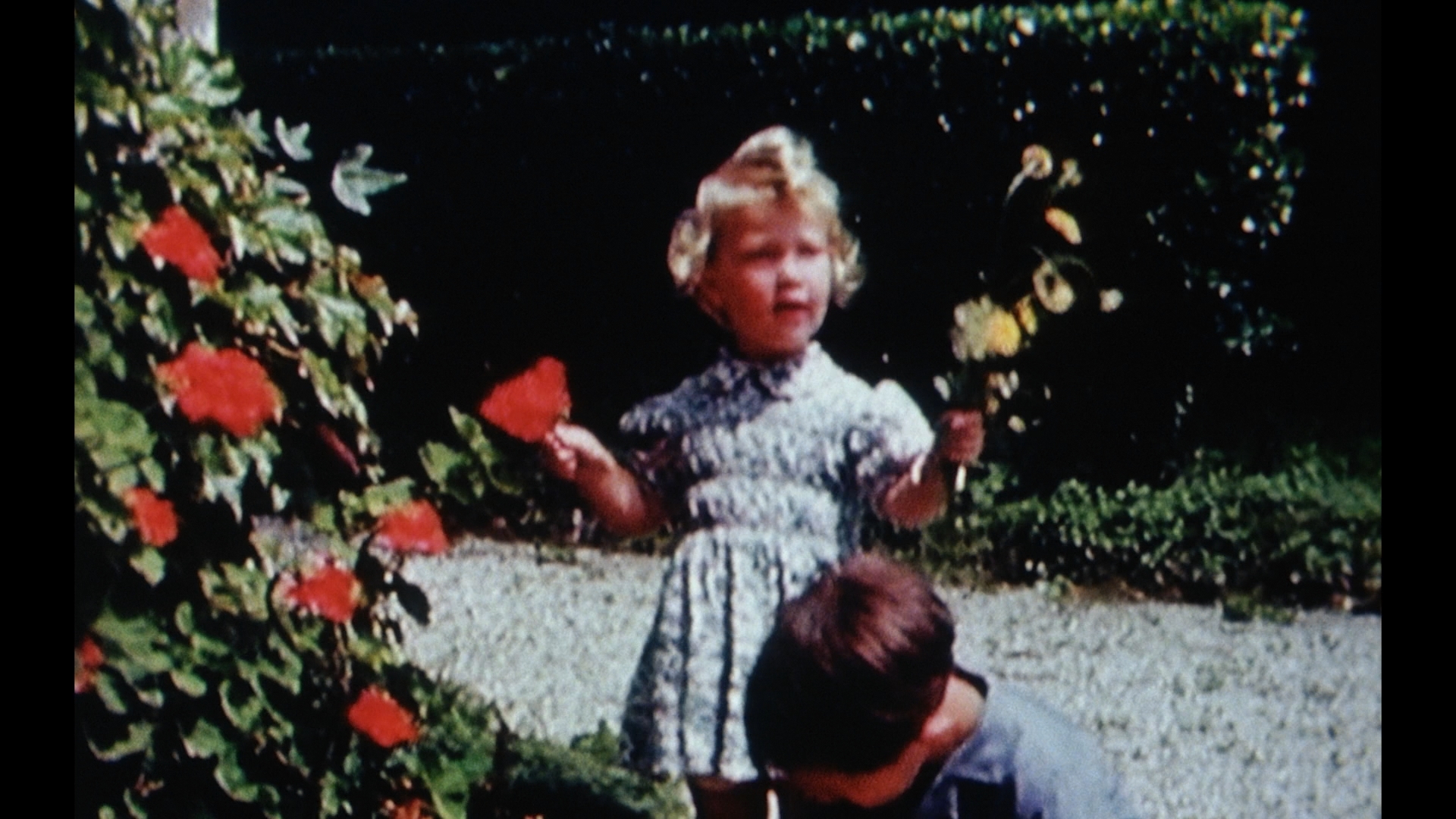 created one of the most extensive, absorbing deep dives into a filmmaker's body of work -- or at least the first half of it -- with the Blu-ray
created one of the most extensive, absorbing deep dives into a filmmaker's body of work -- or at least the first half of it -- with the Blu-ray 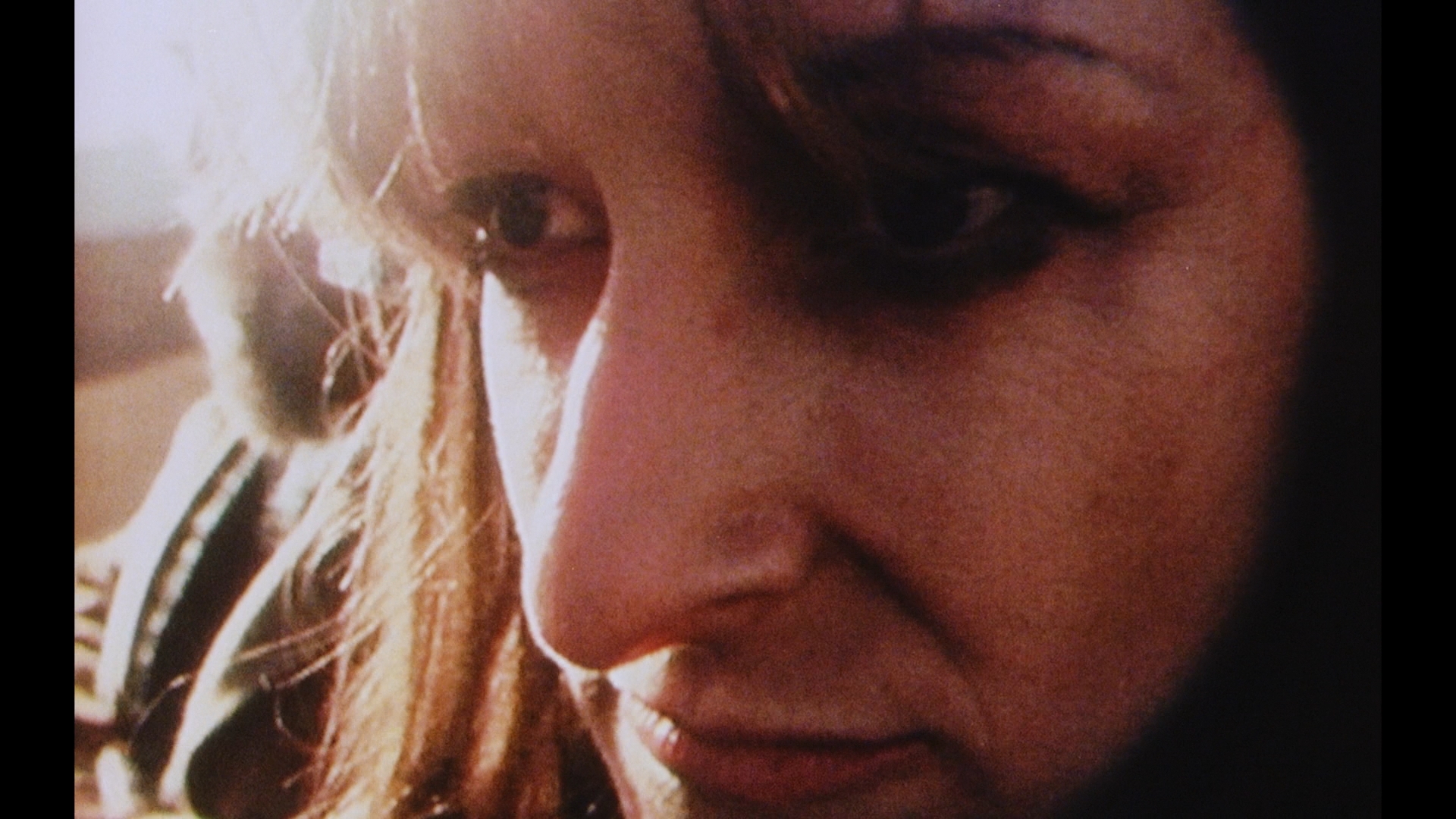 box set, Jarman: Volume 1: 1972-1986. Now the even more elaborate, stuffed-to-the-gills Jarman Volume 2: 1987-1994 brings his remaining features to Blu-ray with six discs jammed with enough material to keep you busy for weeks, essentially an eye-popping film school course in one handy package.
box set, Jarman: Volume 1: 1972-1986. Now the even more elaborate, stuffed-to-the-gills Jarman Volume 2: 1987-1994 brings his remaining features to Blu-ray with six discs jammed with enough material to keep you busy for weeks, essentially an eye-popping film school course in one handy package. place on MTV in its original state, though the deliberately grotesque context of some images (chewed-up food, shaggy beggars foraging in garbage, and all-around despair) don't exactly scream pop charts. Jarman also penned a book to be released along with the film, though the print version
place on MTV in its original state, though the deliberately grotesque context of some images (chewed-up food, shaggy beggars foraging in garbage, and all-around despair) don't exactly scream pop charts. Jarman also penned a book to be released along with the film, though the print version  just barely illuminates its film counterpart as it analyzes the lives of the British people before and during World War II (including his fighter pilot father) compared to the downward spiral and destructive political practices seen in the following decades.
just barely illuminates its film counterpart as it analyzes the lives of the British people before and during World War II (including his fighter pilot father) compared to the downward spiral and destructive political practices seen in the following decades. 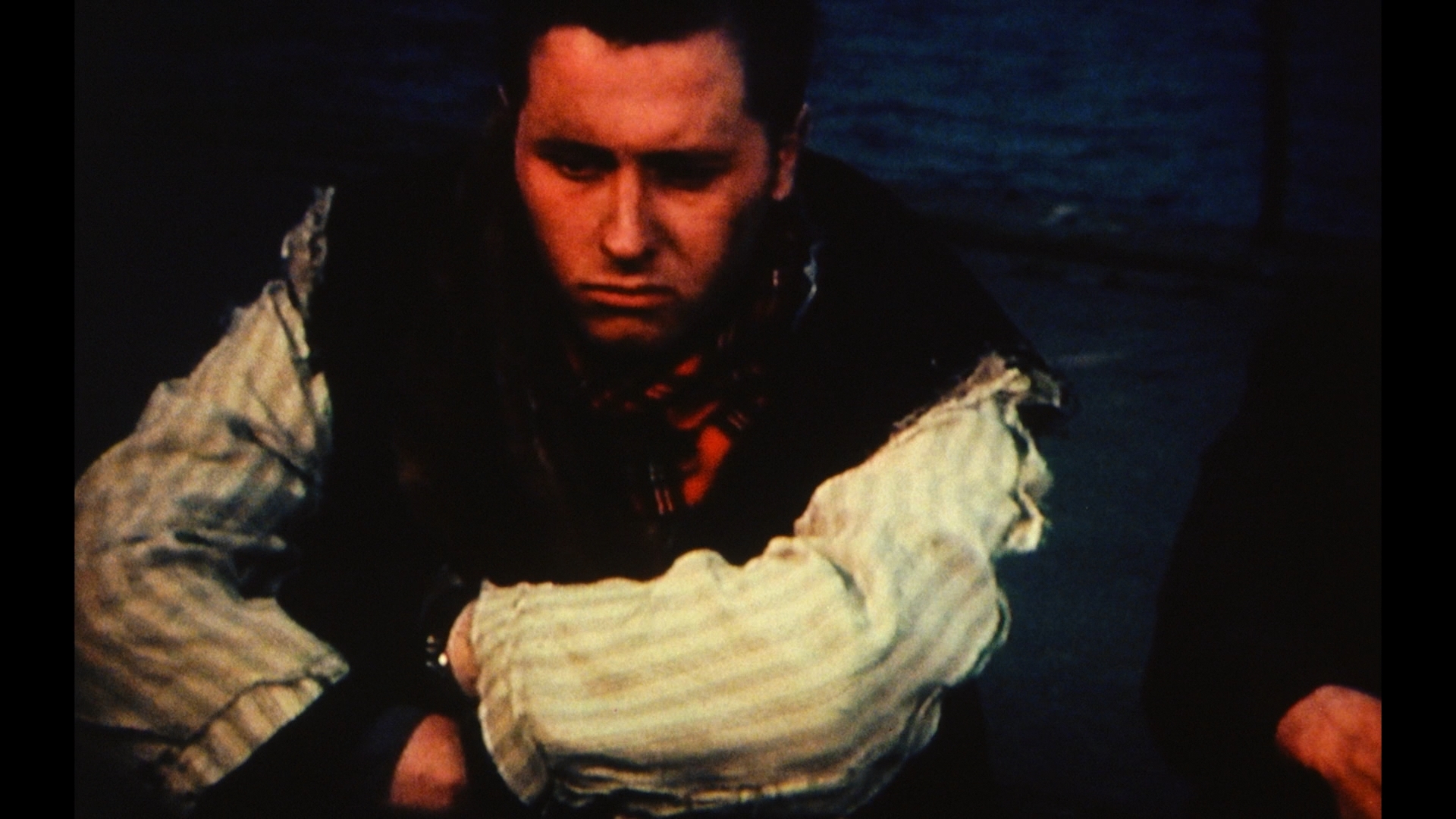
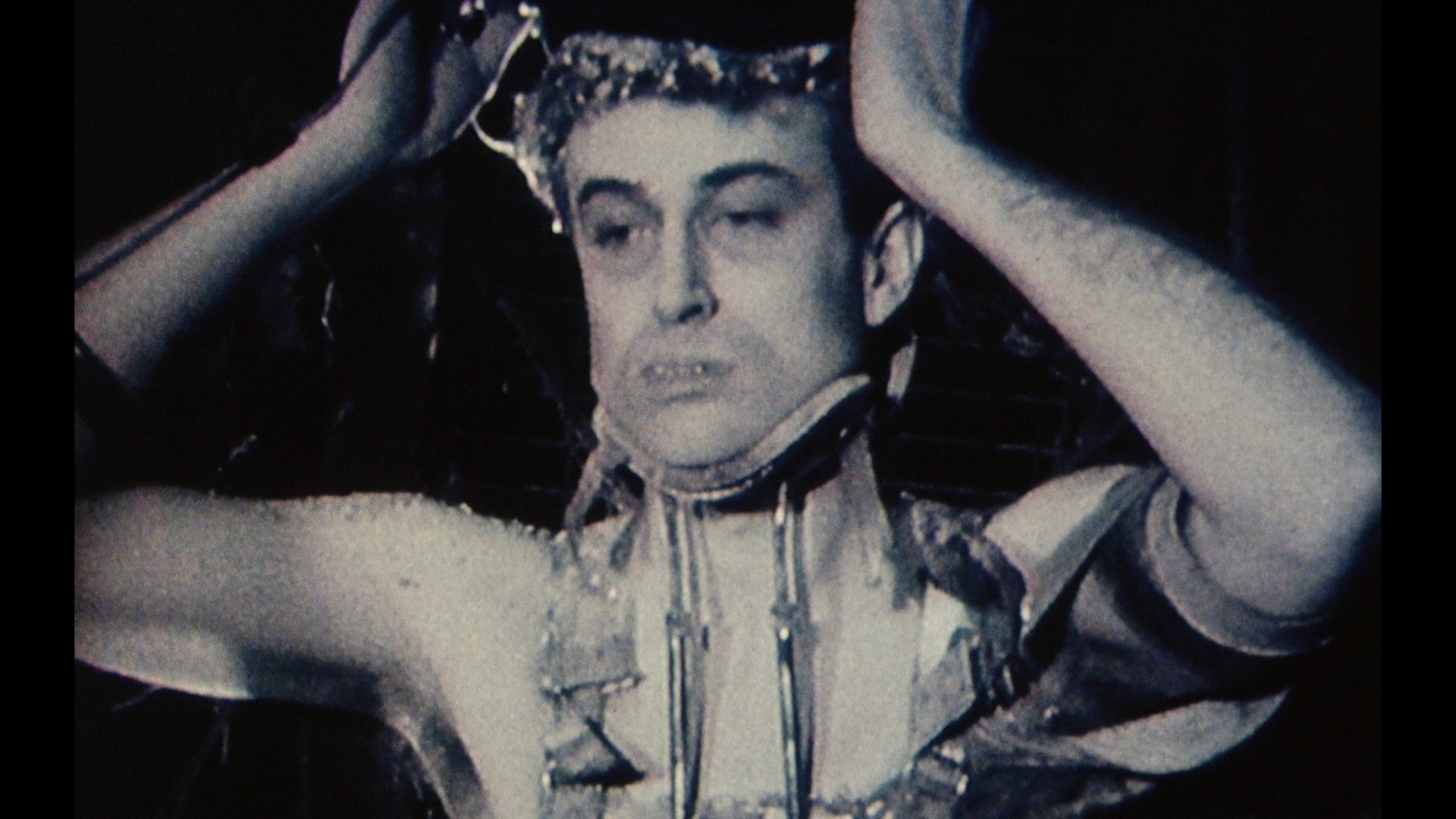 Andrew TIernan in a sort of narrative industrial surrealist short about a young man drifting through a colorful cast of characters and getting seduced by a woman who hangs out with someone in full body bandages, all accompanied by an unnerving soundtrack by Psychic TV and culminating in one of the strangest "sex" scenes around. The short's director, David Lewis, also appears for a new interview (15m15s) about how he first met Jarman at film school and assembled such a wild crew to appear in a film in which the power of the imagery compensated for the fact that "I had no idea what the hell I was talking about!" "Remembering Derek Jarman" (12m36s) from the BFI's 2014 Jarman season event with Richard Heslop and producer James Mackay chatting with BFI curator Will Fowler about their various collaborations including a very interesting bit about The Smiths' "The Queen Is Dead" music video. Mackay also appears in a separate new interview (14m8s) going more in depth about the film's abstract and political nature and how it posed a challenge at festival screenings. "Don Boyd Remembers The Last of England and Aria" (15m38s) offers a production overview of both projects, including the distribution of this feature and a particularly colorful remembrance of how Jarman selected a piece for the latter film, including the amusing idea of selecting a piece with Florence Foster Jenkins. Then Jarman collaborator and occasional co-director John Maybury appears in "Another World for Ourselves" (8m56s), chronicling their path together starting at a Siouxsie and the Banshees concert and extending through years of blending the line between music and cinema. "Isle of Sheppey" (7m) is a rough reel of VHS-shot footage from Jarman's location scout with cultural historian Jon Savage; it's tough to make out what they're saying for the most part, but it's fascinating to follow Jarman's eye behind the camera looking around for potential spots. "Depuis le jour" (4m55s) is Jarman's segment from that opera all-star director omnibus Aria, featuring Swinton looking especially radiant, with optional audio commentary provided by Boyd. In "Another Derek" (4m55s), artist and
Andrew TIernan in a sort of narrative industrial surrealist short about a young man drifting through a colorful cast of characters and getting seduced by a woman who hangs out with someone in full body bandages, all accompanied by an unnerving soundtrack by Psychic TV and culminating in one of the strangest "sex" scenes around. The short's director, David Lewis, also appears for a new interview (15m15s) about how he first met Jarman at film school and assembled such a wild crew to appear in a film in which the power of the imagery compensated for the fact that "I had no idea what the hell I was talking about!" "Remembering Derek Jarman" (12m36s) from the BFI's 2014 Jarman season event with Richard Heslop and producer James Mackay chatting with BFI curator Will Fowler about their various collaborations including a very interesting bit about The Smiths' "The Queen Is Dead" music video. Mackay also appears in a separate new interview (14m8s) going more in depth about the film's abstract and political nature and how it posed a challenge at festival screenings. "Don Boyd Remembers The Last of England and Aria" (15m38s) offers a production overview of both projects, including the distribution of this feature and a particularly colorful remembrance of how Jarman selected a piece for the latter film, including the amusing idea of selecting a piece with Florence Foster Jenkins. Then Jarman collaborator and occasional co-director John Maybury appears in "Another World for Ourselves" (8m56s), chronicling their path together starting at a Siouxsie and the Banshees concert and extending through years of blending the line between music and cinema. "Isle of Sheppey" (7m) is a rough reel of VHS-shot footage from Jarman's location scout with cultural historian Jon Savage; it's tough to make out what they're saying for the most part, but it's fascinating to follow Jarman's eye behind the camera looking around for potential spots. "Depuis le jour" (4m55s) is Jarman's segment from that opera all-star director omnibus Aria, featuring Swinton looking especially radiant, with optional audio commentary provided by Boyd. In "Another Derek" (4m55s), artist and 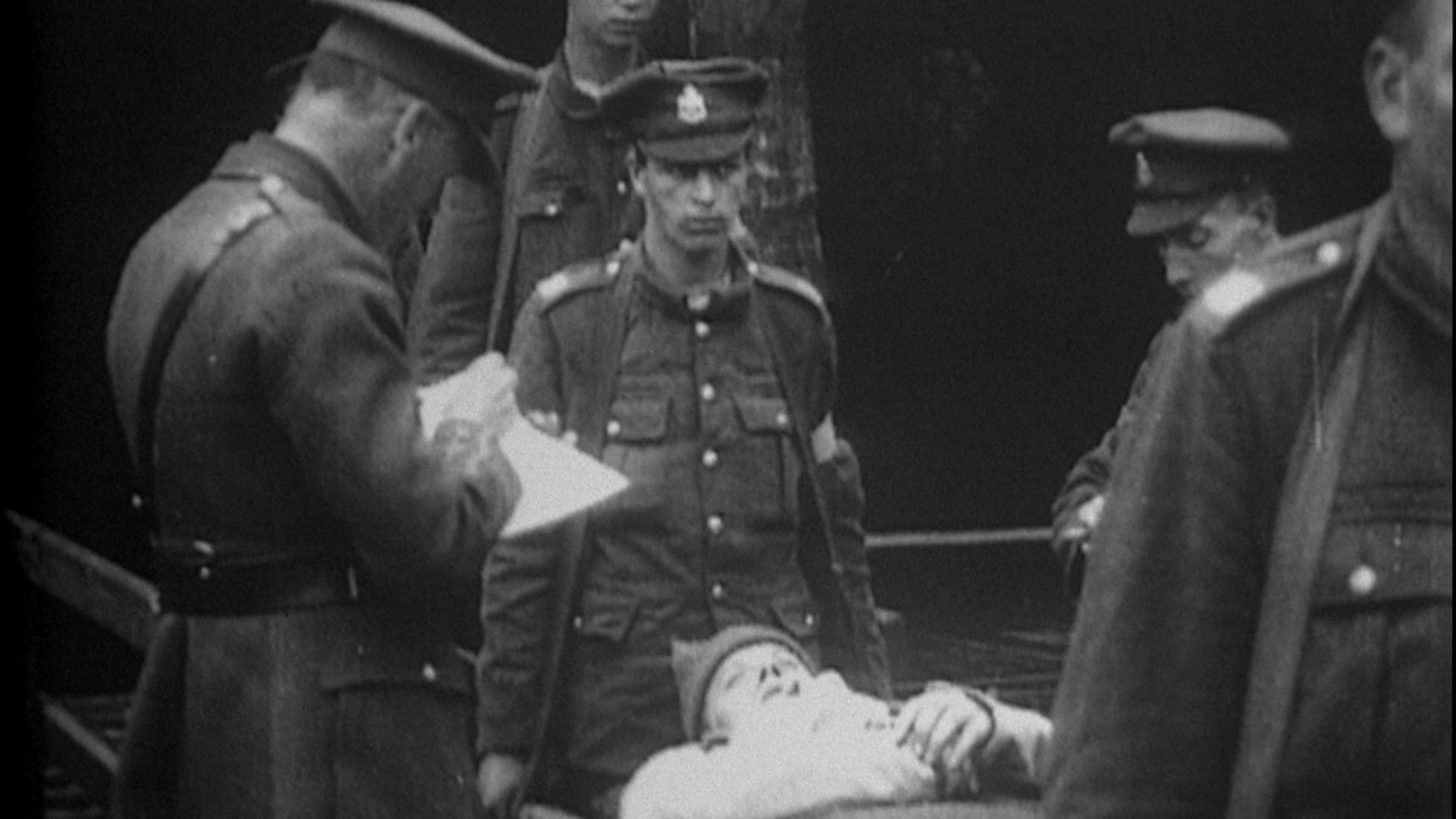 filmmaker John Scarlett-Davis shares his memories of looking after Jarman during shoots and making sure he got where he needed
filmmaker John Scarlett-Davis shares his memories of looking after Jarman during shoots and making sure he got where he needed 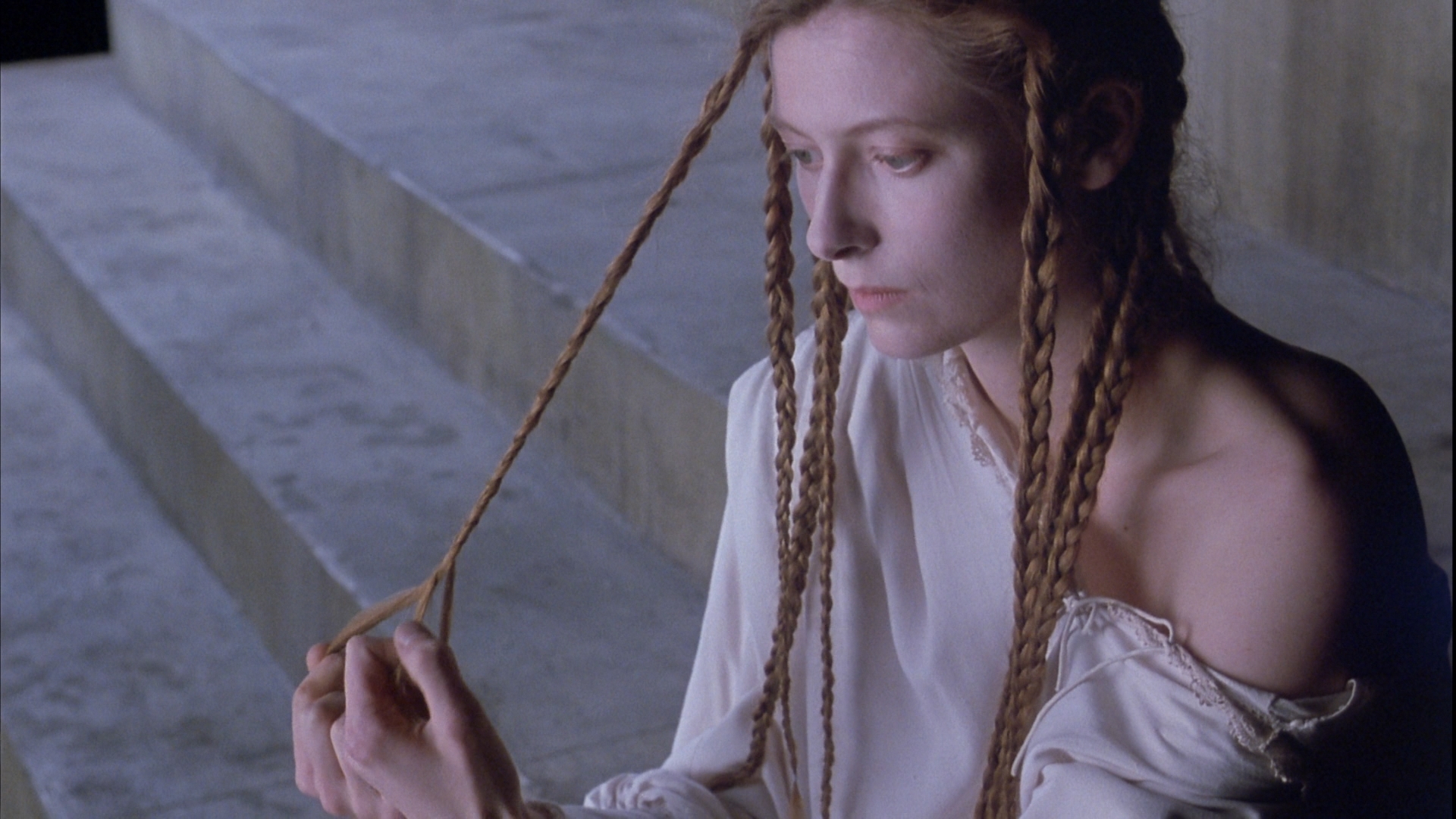 to be safely. Then Lee Drysdale parses out the spirituality and sexuality of Jarman's work in the brief "An Odd Morality" (3m43s) pointing out an almost Catholic sensibility at work in his films. A promo trailer is also included.
to be safely. Then Lee Drysdale parses out the spirituality and sexuality of Jarman's work in the brief "An Odd Morality" (3m43s) pointing out an almost Catholic sensibility at work in his films. A promo trailer is also included. 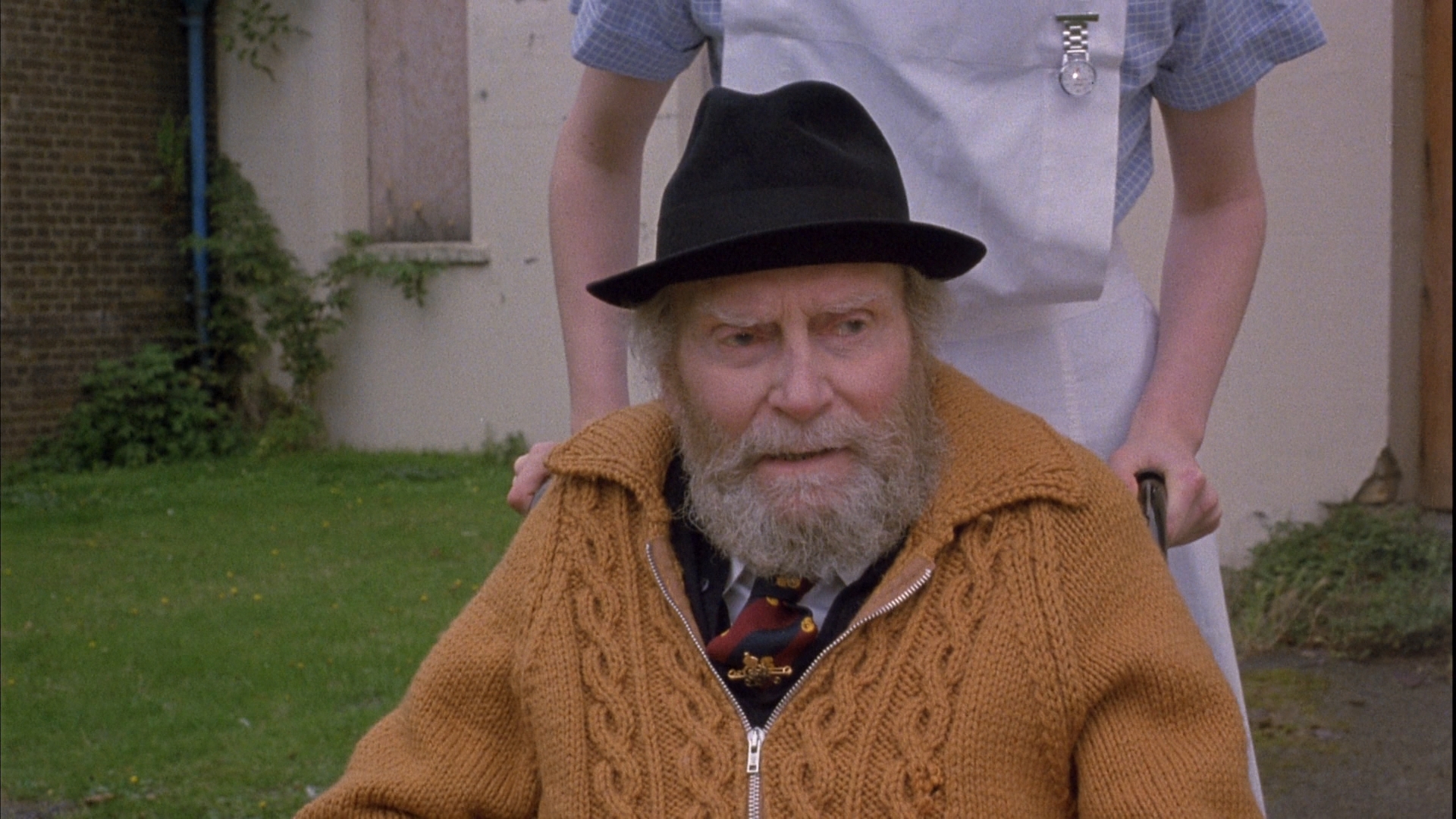 from Kino Lorber. The BFI Blu-ray is one of the most beautiful of all the HD Jarman presentations, which shouldn't be surprising given how painterly and sumptuous it is with more of a focus on bright lighting and detail than some of his other films. The LPCM 2.0 stereo track is gorgeous as well, replicating the original recording with excellent channel separation that makes this a really rewarding headphone experience, too. The film can also be played with an audio commentary by Boyd, who also appears for a new featurette about making the film (38m6s). Between them he goes into great detail about first bringing the project to Jarman, the pivotal use of a then-new Walkman, the surreptitious capturing of Super 8 coverage that proved handy later on, the positive reception on the BBC, and plenty more. The 1989 television Books by My Bedside episode on Jarman (24m51s), timed to coincide with the release of this film, is candid about the challenges he faced in mounting it and a charming snapshot of some of the books that struck his fancy at the moment. "Derek Jarman in Conversation with Simon
from Kino Lorber. The BFI Blu-ray is one of the most beautiful of all the HD Jarman presentations, which shouldn't be surprising given how painterly and sumptuous it is with more of a focus on bright lighting and detail than some of his other films. The LPCM 2.0 stereo track is gorgeous as well, replicating the original recording with excellent channel separation that makes this a really rewarding headphone experience, too. The film can also be played with an audio commentary by Boyd, who also appears for a new featurette about making the film (38m6s). Between them he goes into great detail about first bringing the project to Jarman, the pivotal use of a then-new Walkman, the surreptitious capturing of Super 8 coverage that proved handy later on, the positive reception on the BBC, and plenty more. The 1989 television Books by My Bedside episode on Jarman (24m51s), timed to coincide with the release of this film, is candid about the challenges he faced in mounting it and a charming snapshot of some of the books that struck his fancy at the moment. "Derek Jarman in Conversation with Simon 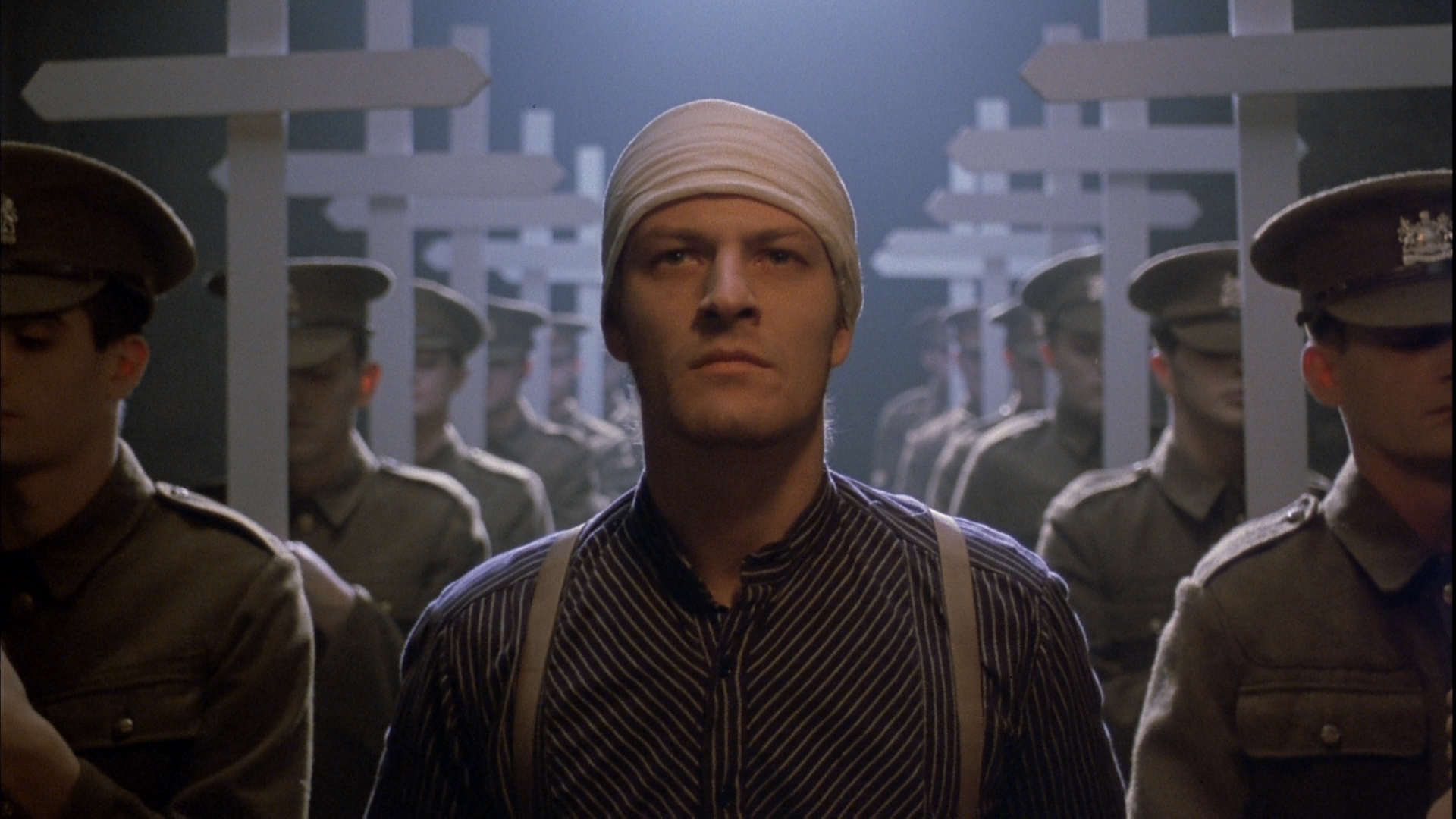 Field" (32m16s) from the same year is a career overview to that point from his first origins in film via Super 8 experimentation through the themes in his work and his opinions on politics and sexual orientation. "Derek Jarman Presents" (26m56s) features Maybury explaining in detail the relationship between Super 8
Field" (32m16s) from the same year is a career overview to that point from his first origins in film via Super 8 experimentation through the themes in his work and his opinions on politics and sexual orientation. "Derek Jarman Presents" (26m56s) features Maybury explaining in detail the relationship between Super 8 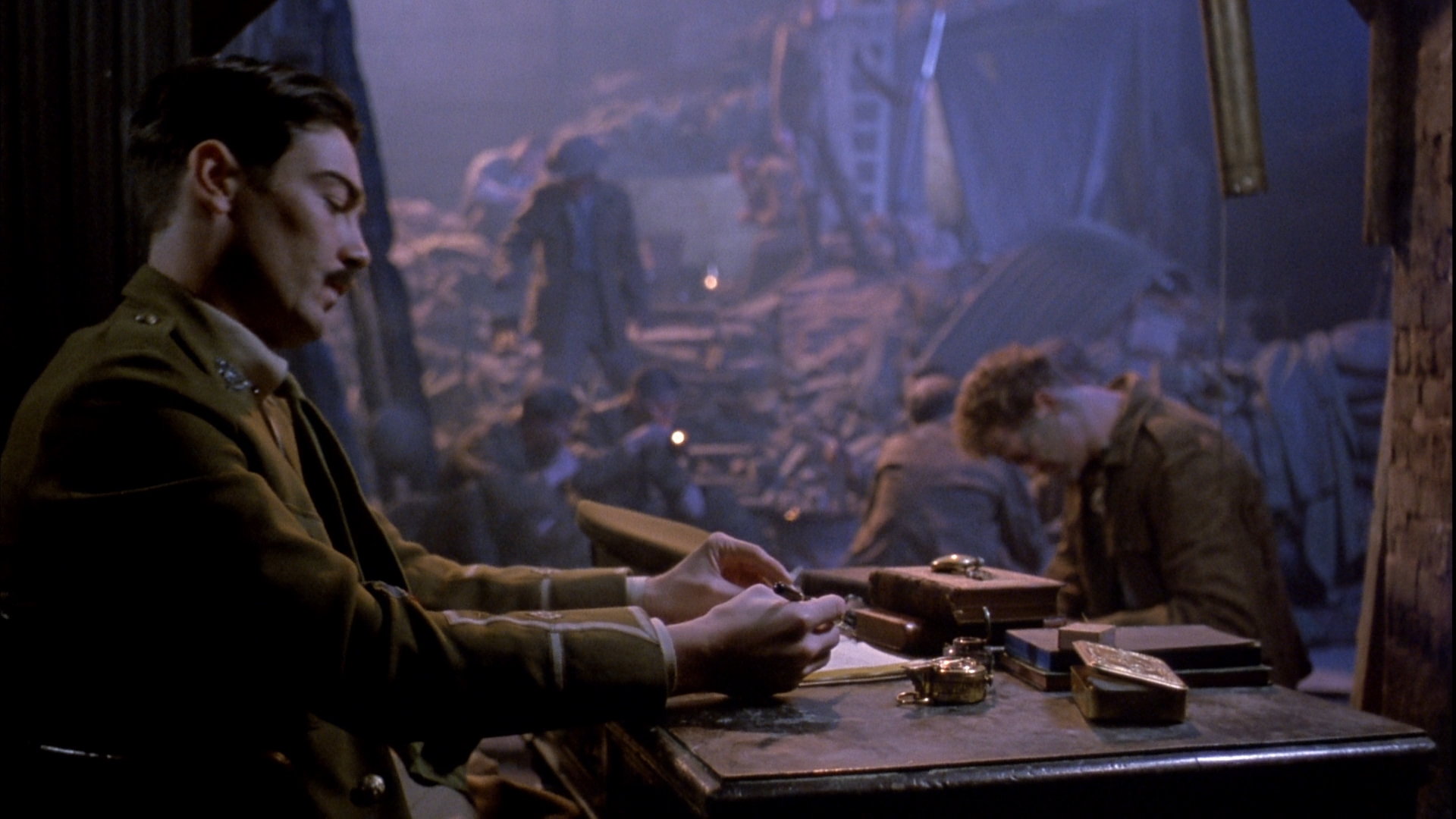 and the burgeoning video aesthetics with influences ranging from Cocteau to music videos, with some interesting asides about things like the Gnostic Gospels. Maybury's also on hand for a separate remembrance about the feature itself (7m59s), covering the nature of the script, the acquisition of film stock, and the research process among other topics. A featurette from the film's 2008 release, "Requiem for Jarman" (36m53s), covers the making of this film with Boyd and Swinton as well as other thoughts on their overall professional relationships with the director. Mackay returns for "Before The Last" (14m51s), a prequel of sorts to his earlier interview in which he discusses working on The Angelic Conversation and the 1984 short film, Imaginging October, as well as "The Nature of Super 8" (8m16s) about his own film background and the functions of Super 8 in the '70s and '80s including its preservation and the issues of copying it. Simon Fisher Turner pops up again for "Caravaggio Was Accidental" (10m9s), a more specific account of how he ended up landing his first fortuitous gig with an anecdote involving picking people up during his driver days. Finally the disc rounds out with the U.K. theatrical trailer, which is quite spectacular.
and the burgeoning video aesthetics with influences ranging from Cocteau to music videos, with some interesting asides about things like the Gnostic Gospels. Maybury's also on hand for a separate remembrance about the feature itself (7m59s), covering the nature of the script, the acquisition of film stock, and the research process among other topics. A featurette from the film's 2008 release, "Requiem for Jarman" (36m53s), covers the making of this film with Boyd and Swinton as well as other thoughts on their overall professional relationships with the director. Mackay returns for "Before The Last" (14m51s), a prequel of sorts to his earlier interview in which he discusses working on The Angelic Conversation and the 1984 short film, Imaginging October, as well as "The Nature of Super 8" (8m16s) about his own film background and the functions of Super 8 in the '70s and '80s including its preservation and the issues of copying it. Simon Fisher Turner pops up again for "Caravaggio Was Accidental" (10m9s), a more specific account of how he ended up landing his first fortuitous gig with an anecdote involving picking people up during his driver days. Finally the disc rounds out with the U.K. theatrical trailer, which is quite spectacular. 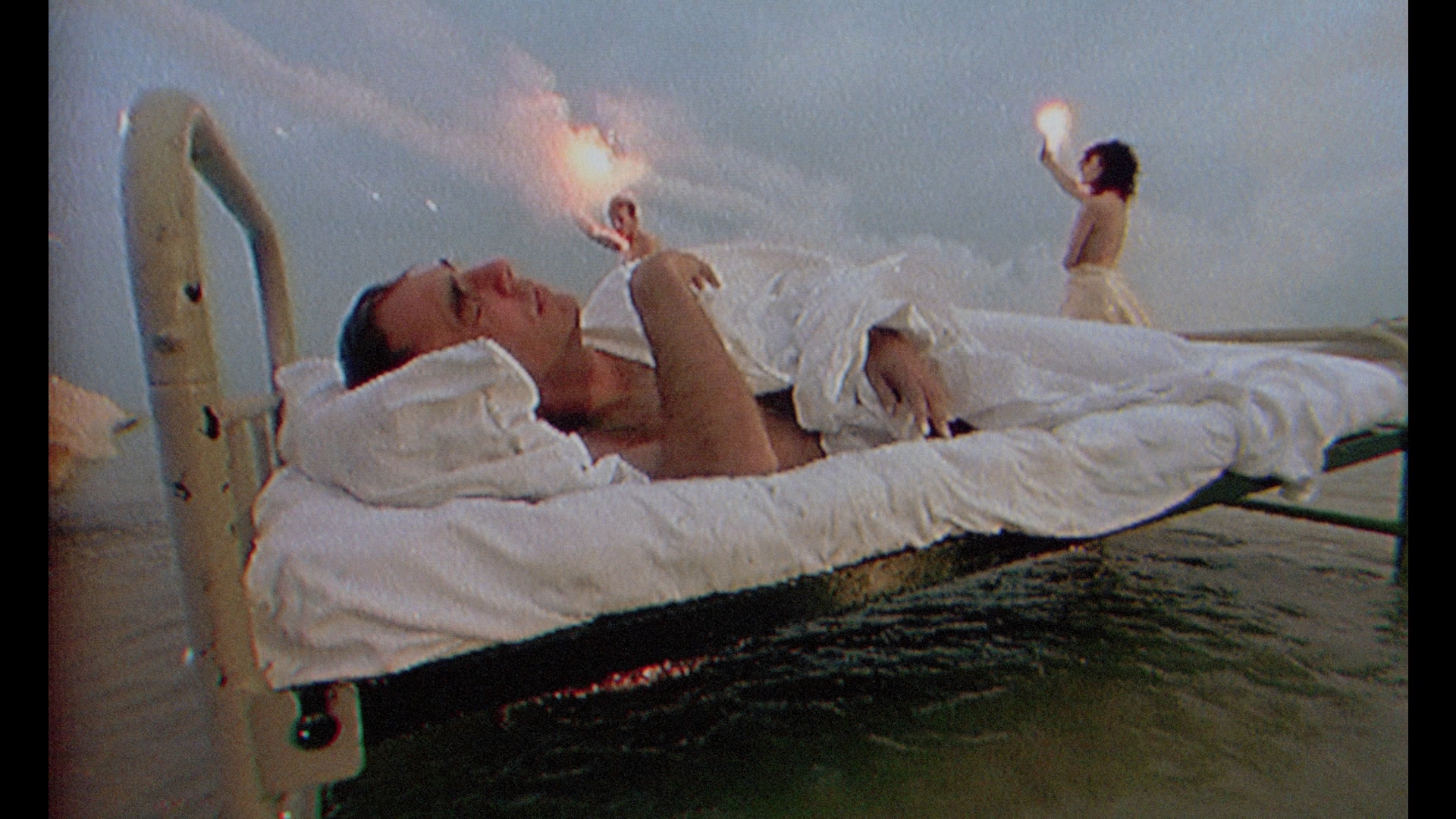 inspired by the Gospels of Matthew and
inspired by the Gospels of Matthew and 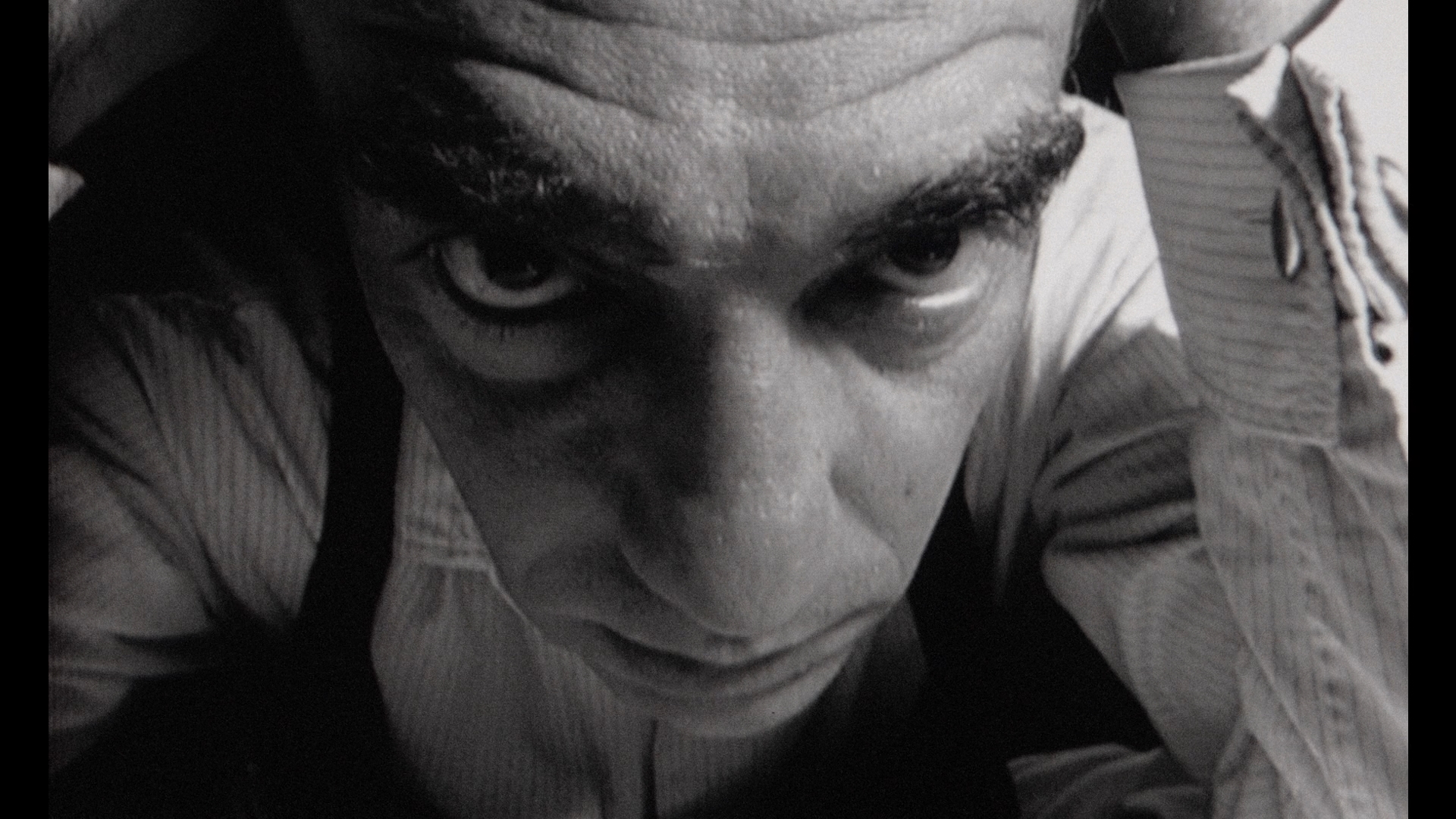 Luke, The Garden finds Jarman back in non-narrative territory with a mixture of lyrical beauty and very aggressive experimentation. He had just been diagnosed with AIDS at the time and made the film around his home in Dungeness, with recent political oppression against homosexuality (particularly in the U.K.) driving the film into more impassioned political territory than ever. His music video influence also shines through as the film loosely charts the persecution of a gay couple by society at large, intercut with recurring images of a celebrity Madonna (Swinton) and New Testament imagery involving Christ and Judas. It's also driven heavily by an intricate sound design by Turner, whose score is so firmly ingrained into the rest of the mix that it's frequently difficult to separate the two. The film is also something of a mixed media experiment with Super 8 manipulated through video editing into something intentionally gritty and lo-res for the most part, in keeping with the caustic nature of the film itself.
Luke, The Garden finds Jarman back in non-narrative territory with a mixture of lyrical beauty and very aggressive experimentation. He had just been diagnosed with AIDS at the time and made the film around his home in Dungeness, with recent political oppression against homosexuality (particularly in the U.K.) driving the film into more impassioned political territory than ever. His music video influence also shines through as the film loosely charts the persecution of a gay couple by society at large, intercut with recurring images of a celebrity Madonna (Swinton) and New Testament imagery involving Christ and Judas. It's also driven heavily by an intricate sound design by Turner, whose score is so firmly ingrained into the rest of the mix that it's frequently difficult to separate the two. The film is also something of a mixed media experiment with Super 8 manipulated through video editing into something intentionally gritty and lo-res for the most part, in keeping with the caustic nature of the film itself. 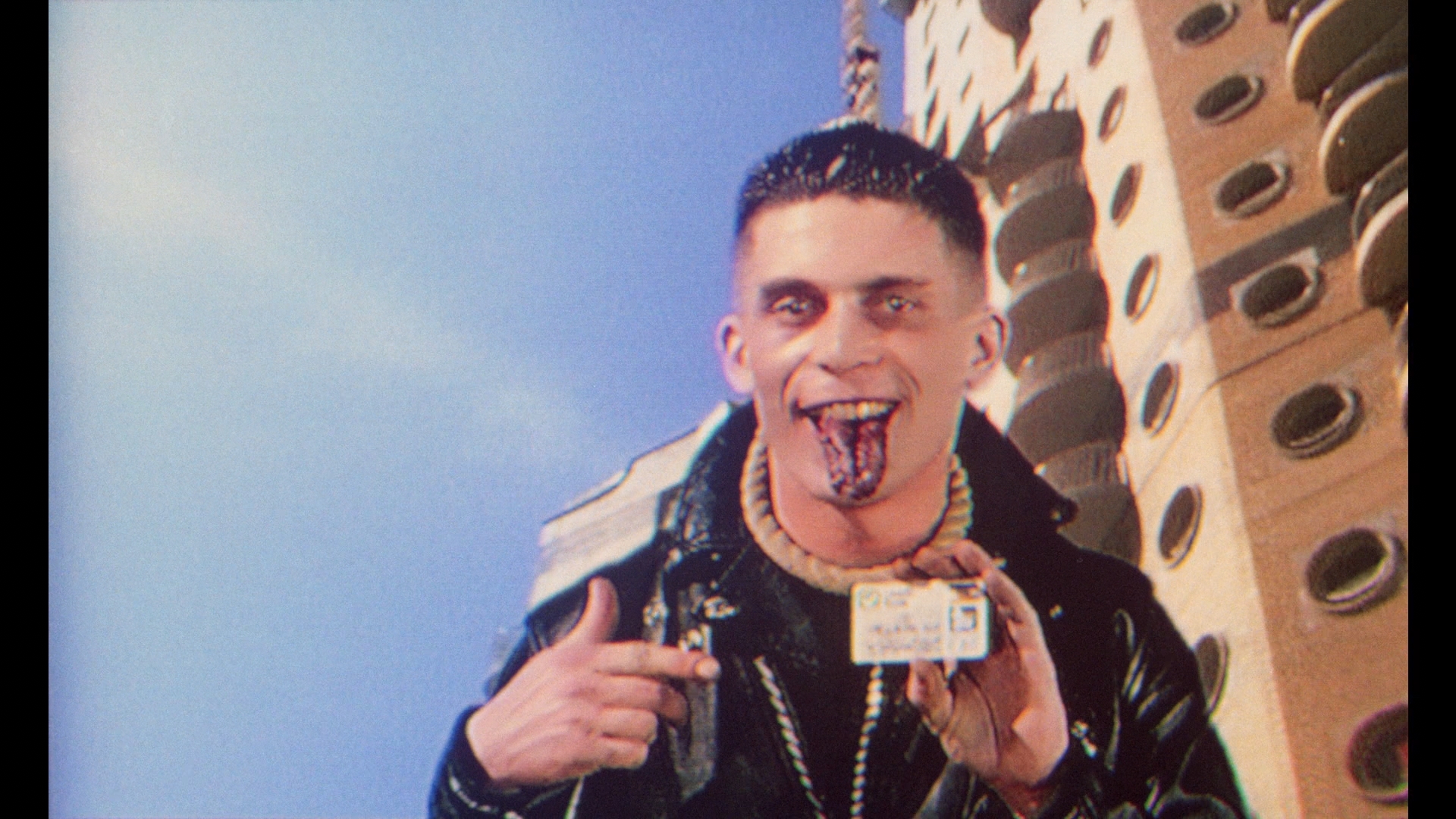 looked
looked 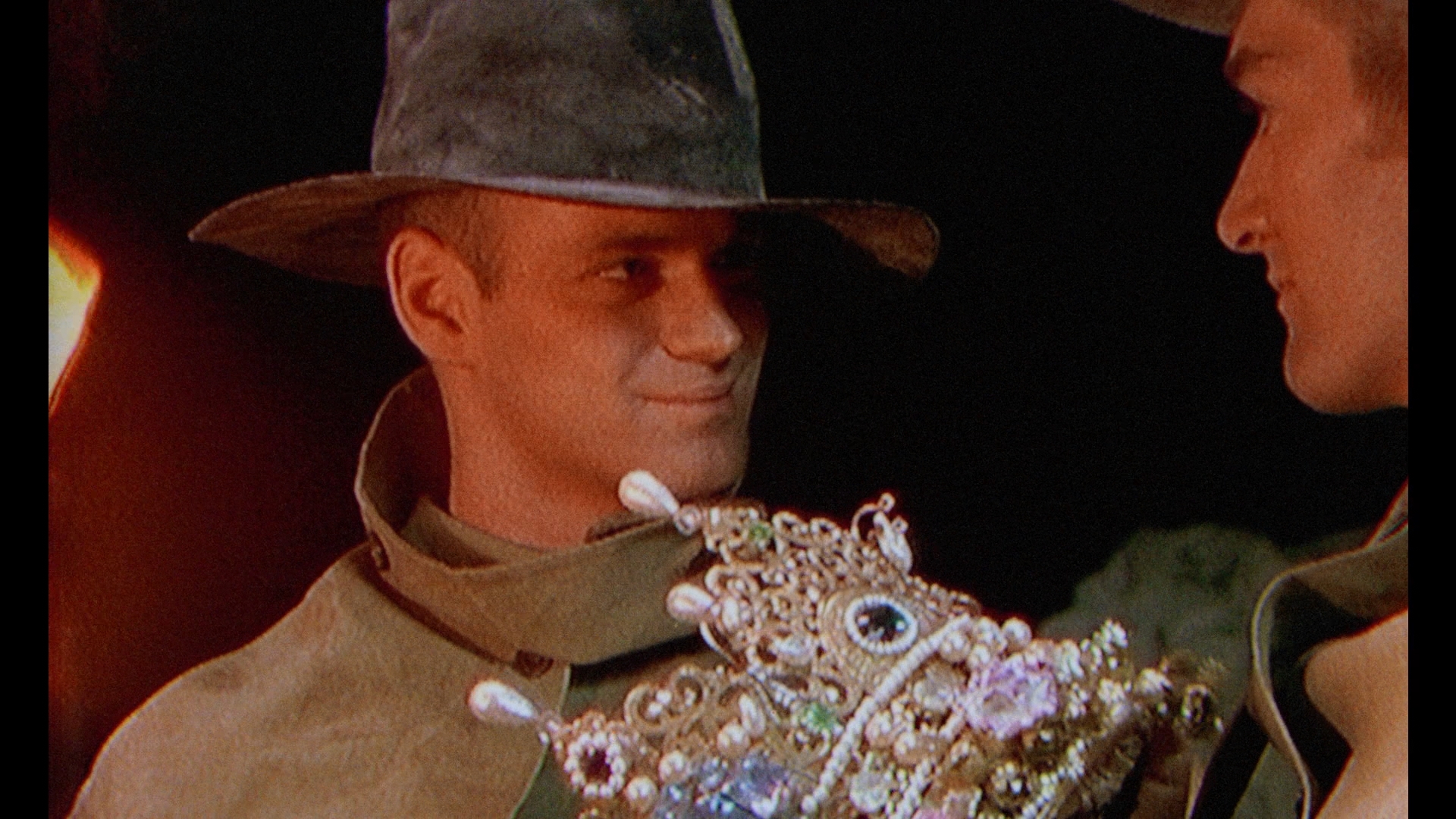 awful in previous transfers). Though it features no commentary, The Garden does benefit from both a 2.0 LPCM stereo track and a very active DTS-HD 5.1 mix that's guaranteed to jolt you several times. "Derek's Shoot in Dungeness" (6m27s) from 1990 is a raw batch of Super 8 production footage of the smiling director and crew at work, while "The Wanderer" (31m22s) is a 1991 experimental short by Lewis with Michael York, Michael Gough, and narration by Phil Daniels and Imogen Stubbs, contrasting the ancient Anglo-Saxon poem of the same name with modern images of fire, loneliness, and violence. Activism takes center stage in "Kiss 25 Goodbye" (6m37s), a very jagged, stylized depiction of a 1991 OutRage protest at a police station, while "Clause and Effect" (19m22s) features Jarman and other members of the political and artistic gay community discussing the social climate of the period, the impact on AIDS on public perception, and the particularly odious Clause 28, designed by the government to essentially squelch any "promotion" of homosexuality in the vaguest possible terms. "Orange Juice" (41m18s) offers a lengthy camcorder-shot reel of coverage during the making of a music video for
awful in previous transfers). Though it features no commentary, The Garden does benefit from both a 2.0 LPCM stereo track and a very active DTS-HD 5.1 mix that's guaranteed to jolt you several times. "Derek's Shoot in Dungeness" (6m27s) from 1990 is a raw batch of Super 8 production footage of the smiling director and crew at work, while "The Wanderer" (31m22s) is a 1991 experimental short by Lewis with Michael York, Michael Gough, and narration by Phil Daniels and Imogen Stubbs, contrasting the ancient Anglo-Saxon poem of the same name with modern images of fire, loneliness, and violence. Activism takes center stage in "Kiss 25 Goodbye" (6m37s), a very jagged, stylized depiction of a 1991 OutRage protest at a police station, while "Clause and Effect" (19m22s) features Jarman and other members of the political and artistic gay community discussing the social climate of the period, the impact on AIDS on public perception, and the particularly odious Clause 28, designed by the government to essentially squelch any "promotion" of homosexuality in the vaguest possible terms. "Orange Juice" (41m18s) offers a lengthy camcorder-shot reel of coverage during the making of a music video for 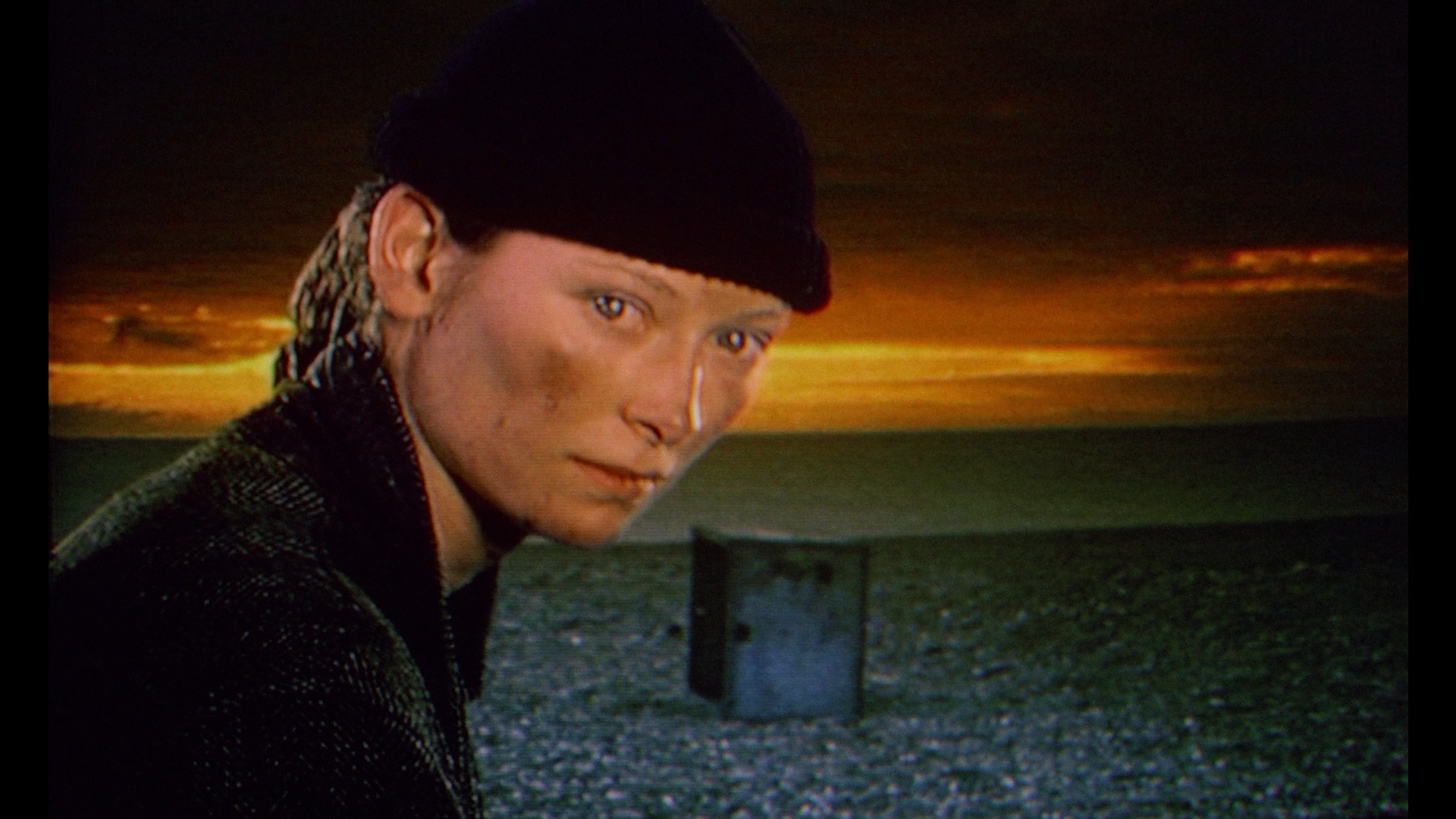 the band of
the band of 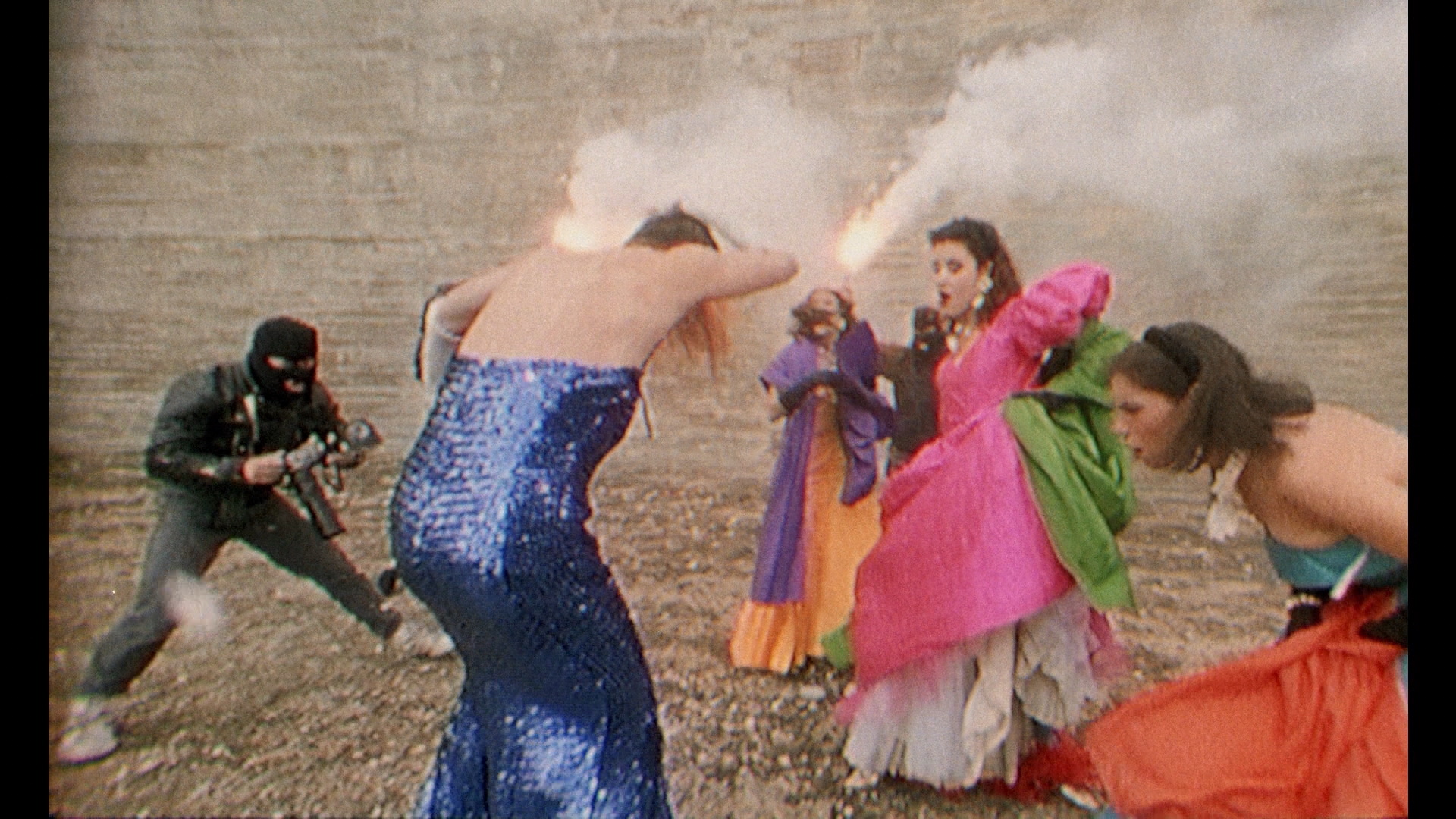 the same name, for the song "What Presence?!" 2015's "Shooting the Hunter" (5m23s) is an avant garde homage to Jarman by Mark French and Richard Heslop using new location footage and vintage, manipulated Super 8 shots, while Heslop turning up against for "Anything Can Happen" (11m17s), a new interview about scrappy production methods before and during the availability of videotape with other media coming in and out of play. Mackay also returns for an interview (14m36s) about the "stressful" shoot with Jarman's enthusiasm somewhat compensating for his sudden health issues. There's also another segment with Lewis (16m3s) talking about his time on the film as well after bonding with Jarman during a problem-plagued car ride. Maybury appears for "The Other Great Masterpiece" (6m10s) about Jarman's legendary fondness for gardening and his personal "sacred space" garden, and keep your ears open for a fleeting and hilarious bit about the BBC and Jeff Stryker. Finally the disc closes out with the trailer and "Life with Derek" (44m28s), an audio-only selection of Turner's recordings of Jarman and their friends over the years.
the same name, for the song "What Presence?!" 2015's "Shooting the Hunter" (5m23s) is an avant garde homage to Jarman by Mark French and Richard Heslop using new location footage and vintage, manipulated Super 8 shots, while Heslop turning up against for "Anything Can Happen" (11m17s), a new interview about scrappy production methods before and during the availability of videotape with other media coming in and out of play. Mackay also returns for an interview (14m36s) about the "stressful" shoot with Jarman's enthusiasm somewhat compensating for his sudden health issues. There's also another segment with Lewis (16m3s) talking about his time on the film as well after bonding with Jarman during a problem-plagued car ride. Maybury appears for "The Other Great Masterpiece" (6m10s) about Jarman's legendary fondness for gardening and his personal "sacred space" garden, and keep your ears open for a fleeting and hilarious bit about the BBC and Jeff Stryker. Finally the disc closes out with the trailer and "Life with Derek" (44m28s), an audio-only selection of Turner's recordings of Jarman and their friends over the years. 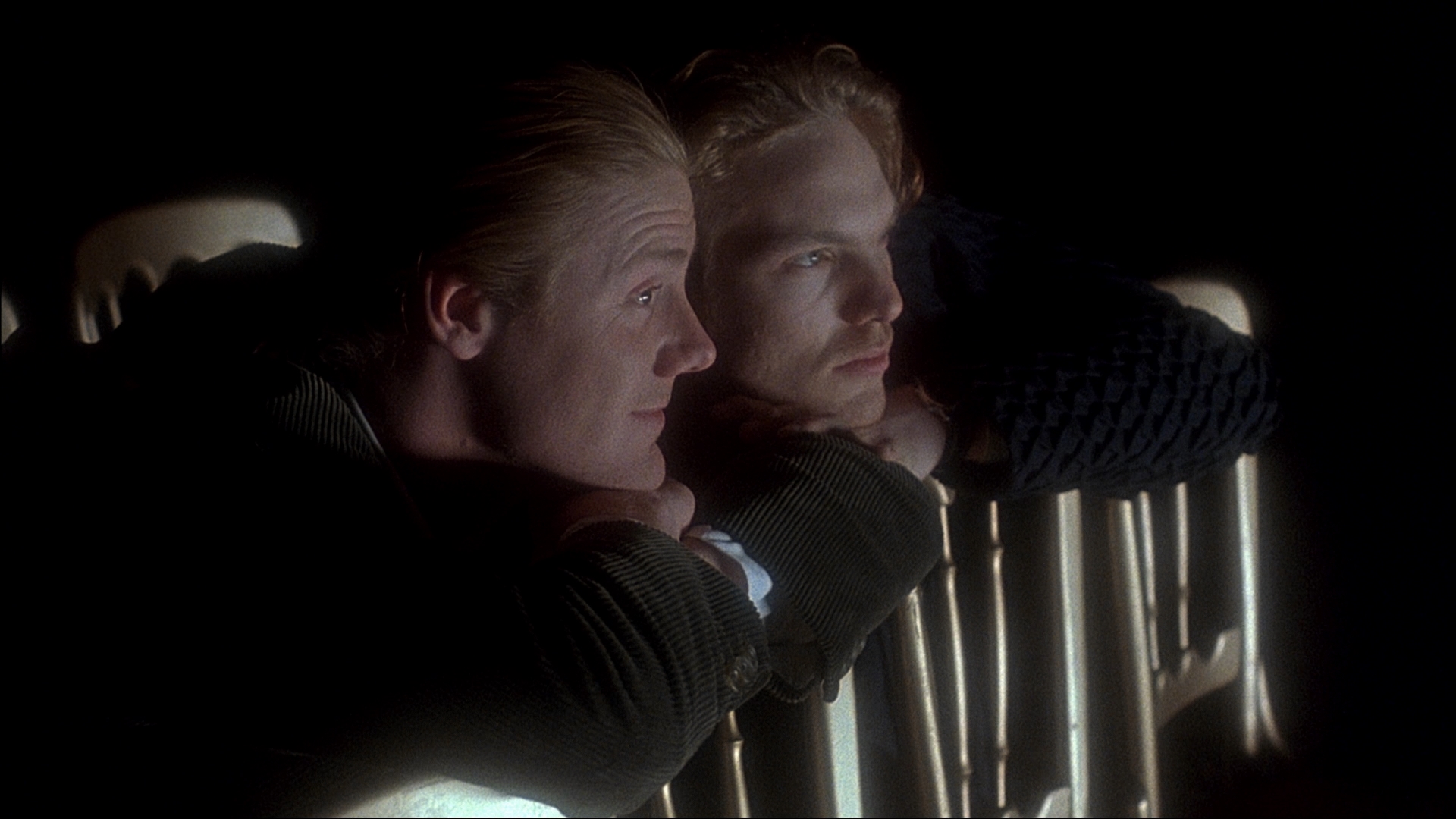 Thanks to
Thanks to 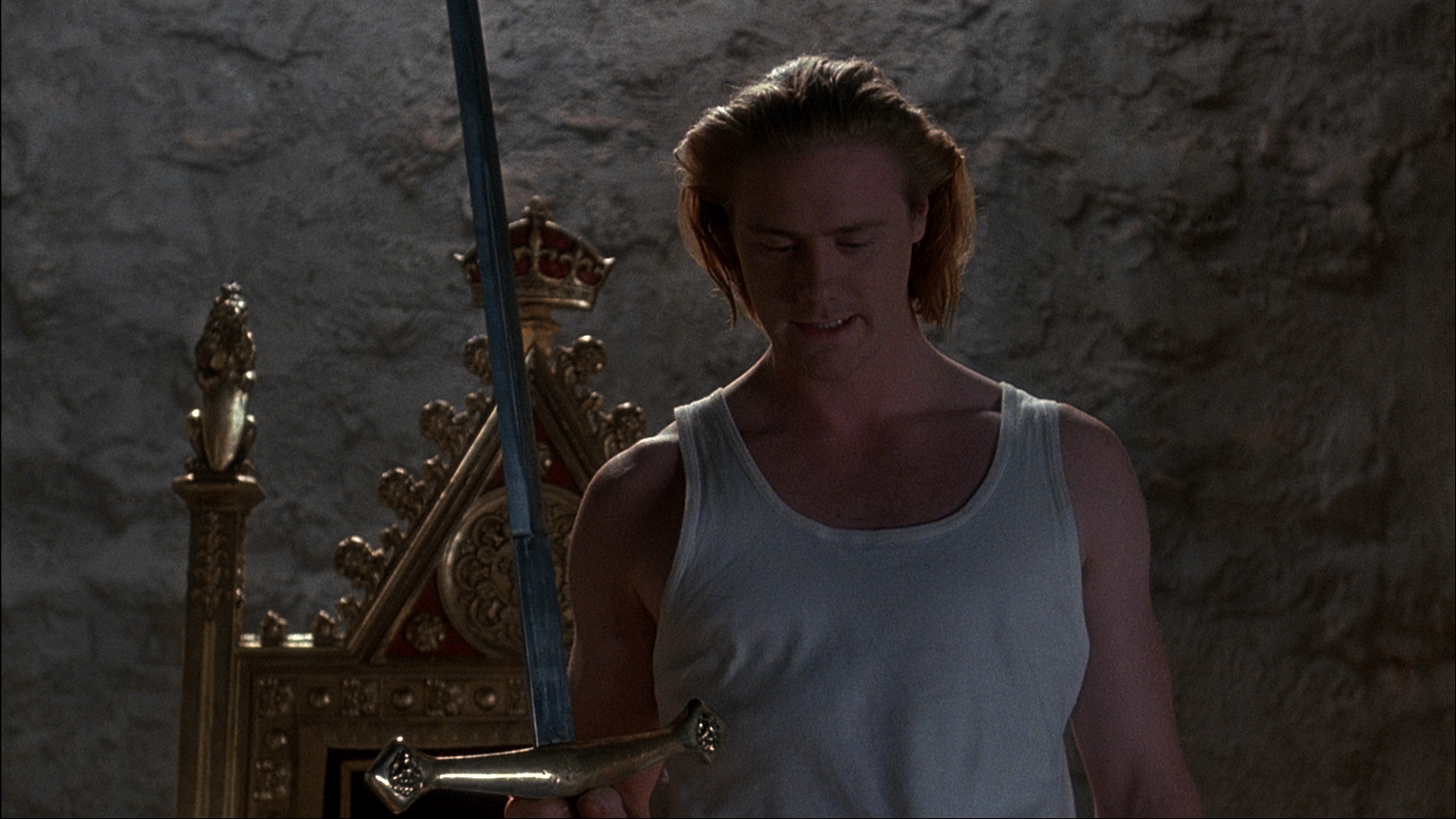 Fine Line, Jarman had his biggest theatrical release in the U.S. with his next film, Edward II, an adaptation of Christopher Marlowe's tragedy about the turmoil begun when the titular king (Waddington) brings his exiled lover, the lower class Gaveston (Tiernan), back into the fold and grants his privileges that displease those around him. Chief among his enemies during the power struggle are Edward's wife, Isabella (Swinton), and military leader Lord Mortimer (Terry), who becomes her lover. Meanwhile Edward and Isabella's neglected son becomes a pawn in the feud, with a darkly poetic outcome in store. Jarman's vision places the drama in a stark, spare setting of gray walls and dark lighting, with modern elements added like recurring Outrage gay rights activists and, in one of the most memorable scenes, an appearance by Annie Lennox singing "Ev'ry Time We Say Goodbye."
Fine Line, Jarman had his biggest theatrical release in the U.S. with his next film, Edward II, an adaptation of Christopher Marlowe's tragedy about the turmoil begun when the titular king (Waddington) brings his exiled lover, the lower class Gaveston (Tiernan), back into the fold and grants his privileges that displease those around him. Chief among his enemies during the power struggle are Edward's wife, Isabella (Swinton), and military leader Lord Mortimer (Terry), who becomes her lover. Meanwhile Edward and Isabella's neglected son becomes a pawn in the feud, with a darkly poetic outcome in store. Jarman's vision places the drama in a stark, spare setting of gray walls and dark lighting, with modern elements added like recurring Outrage gay rights activists and, in one of the most memorable scenes, an appearance by Annie Lennox singing "Ev'ry Time We Say Goodbye." 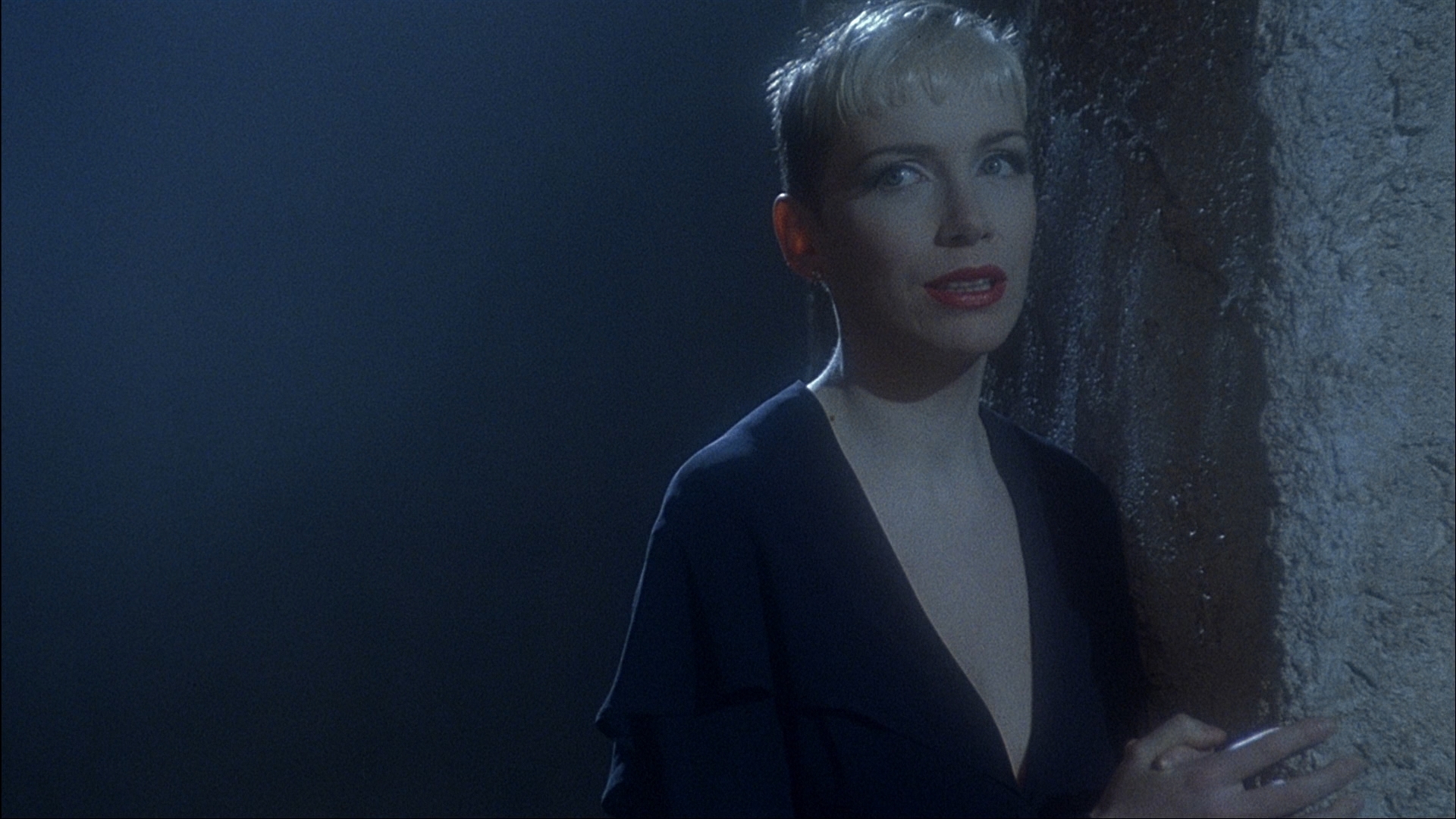 Second Sight adds on a very good new Severin Films featurette, "Derek's Edward" (23m37s), with Waddington and producers Antony Root and Steve Clark-Hall discussing the film's origins as a BBC TV project, Jarman's life at the time in Dungeness,
Second Sight adds on a very good new Severin Films featurette, "Derek's Edward" (23m37s), with Waddington and producers Antony Root and Steve Clark-Hall discussing the film's origins as a BBC TV project, Jarman's life at the time in Dungeness,  Swinton's key involvement in the script, and the casting process including some "mini-drama" when Waddington almost had to leave for another project. That featurette is carried over on both the U.S. and U.K. Blu-rays, with the former adding a video essay by Bruce La Bruce about the film. The BFI is much more robust in the extras department though including the fascinating 1987 student short film "Ostia" (26m46s), with Jarman playing director Pier Paolo Pasolini driving his Alfa Romeo around on his last day on earth before his notorious murder. It's obviously rough around the edges but quite ambitious and stylish, particularly in the second half. Director Julian Cole also contributes an audio commentary with some interesting tidbits like the attempted casting to Terence Stamp. Jarman also stars in another short film, 1993's "The Clearing" (7m12s), directed by Alex Bistikas, which starts off as a subjective walk through a cruising area in the woods but gets much stranger and quirkier as it progresses. Turner appears again for "Cut/Action" (7m57s), a video essay comprised of photos (personal snapshots, posters, and other ephemera) and
Swinton's key involvement in the script, and the casting process including some "mini-drama" when Waddington almost had to leave for another project. That featurette is carried over on both the U.S. and U.K. Blu-rays, with the former adding a video essay by Bruce La Bruce about the film. The BFI is much more robust in the extras department though including the fascinating 1987 student short film "Ostia" (26m46s), with Jarman playing director Pier Paolo Pasolini driving his Alfa Romeo around on his last day on earth before his notorious murder. It's obviously rough around the edges but quite ambitious and stylish, particularly in the second half. Director Julian Cole also contributes an audio commentary with some interesting tidbits like the attempted casting to Terence Stamp. Jarman also stars in another short film, 1993's "The Clearing" (7m12s), directed by Alex Bistikas, which starts off as a subjective walk through a cruising area in the woods but gets much stranger and quirkier as it progresses. Turner appears again for "Cut/Action" (7m57s), a video essay comprised of photos (personal snapshots, posters, and other ephemera) and 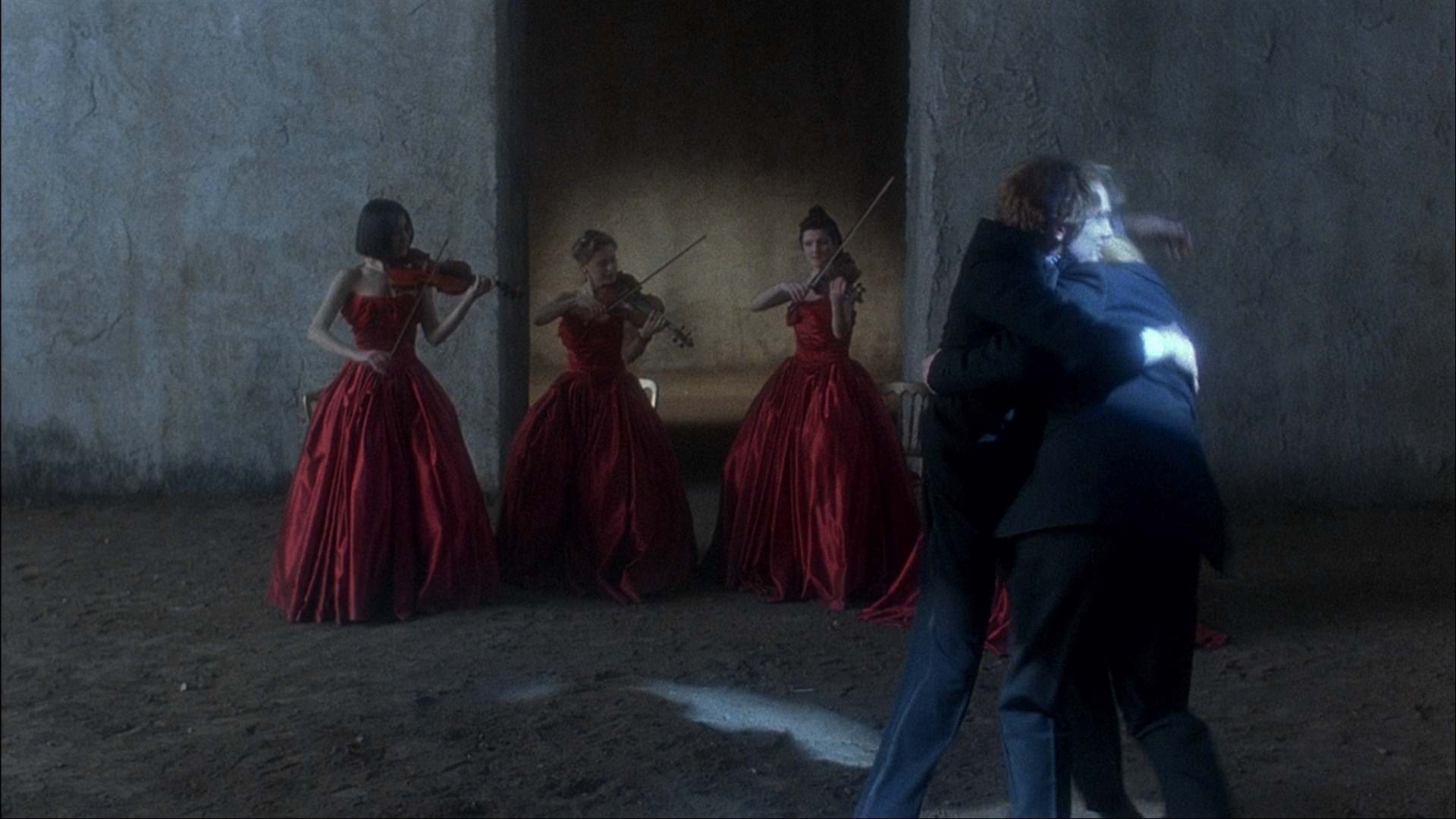 verbal recollections about their friends and memories from Caravaggio onward. An interview with Lewis (3m56s) focuses on this film and the effect that constrained budgets had on Jarman's films, often to their benefit in the long run. In "The Same Spirit" (5m53s),
verbal recollections about their friends and memories from Caravaggio onward. An interview with Lewis (3m56s) focuses on this film and the effect that constrained budgets had on Jarman's films, often to their benefit in the long run. In "The Same Spirit" (5m53s), 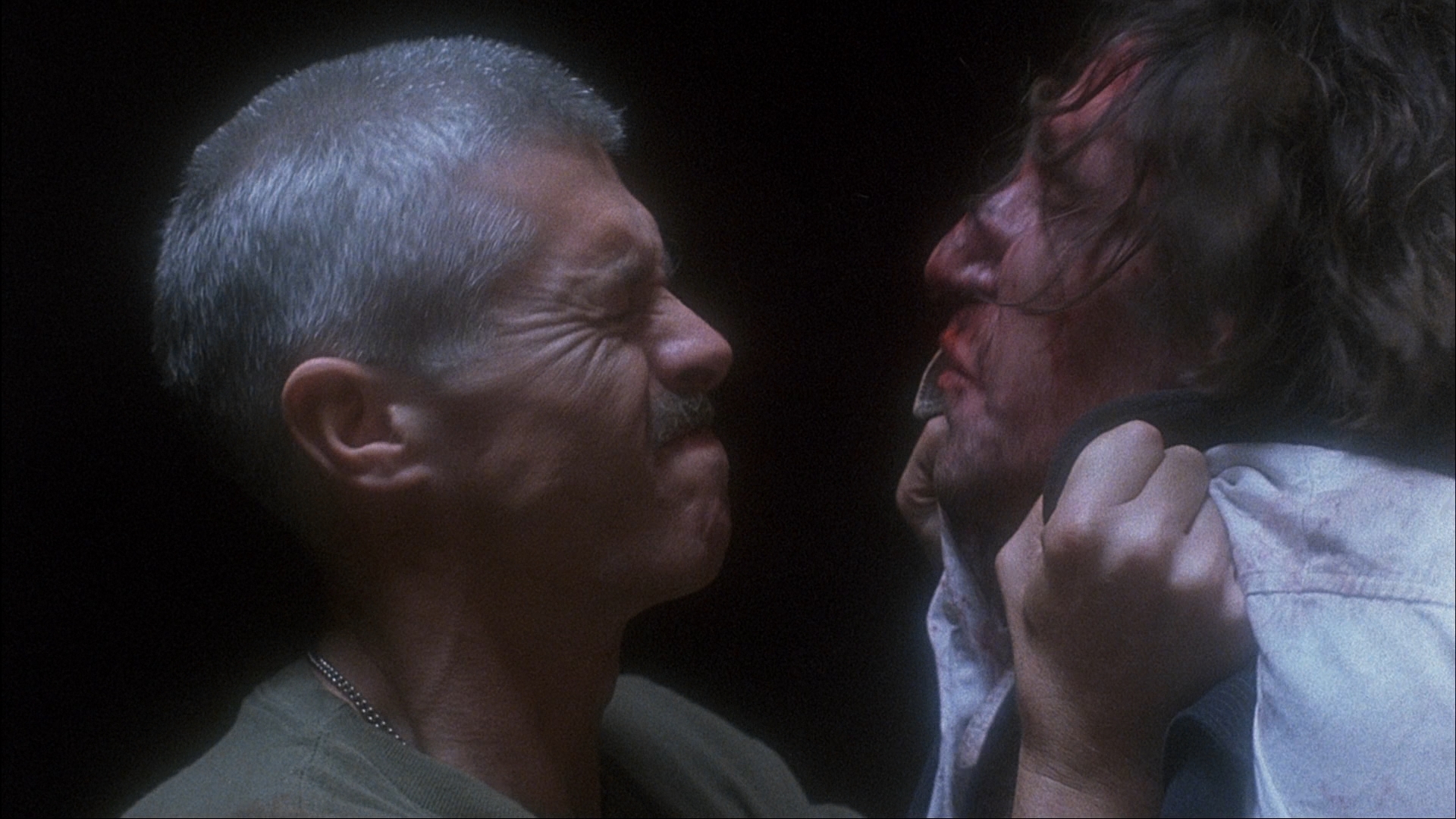 Boyd wistfully recalls the director's later years and increased, anti-Thatcher political passions that came to the fore around that time. Then legendary, award-winning costume designer Sandy Powell appears for the new "Truly Beautiful" (18m37s) covering her career path and her interactions with Jarman that led to her stunning work on Edward II after doing music videos and Caravaggio with him. An audio-only National Film Theatre interview with Jarman by Colin McCabe (96m57s) is a bit difficult to hear at times but makes for an invaluable record of Jarman's mindset around the time of the film's release including his thoughts on necessary changes to the adaptation, the sympathy (or lack thereof) for Gaveston's character, and thoughts on British royal culture. It's also the funniest you'll hear him on any of these releases as he's obviously in a very happy and witty mood. There's also an extended Jarman interview just between McCabe and Jarman recorded in 1991 (recorded on SD video), focusing more on his entire life from his childhood through his entry into the movie world through production design and then directing. The image quality of the feature is excellent, retaining the dark, grainy look of the 35mm production but looking very colorful and sharp when required. The LPCM
Boyd wistfully recalls the director's later years and increased, anti-Thatcher political passions that came to the fore around that time. Then legendary, award-winning costume designer Sandy Powell appears for the new "Truly Beautiful" (18m37s) covering her career path and her interactions with Jarman that led to her stunning work on Edward II after doing music videos and Caravaggio with him. An audio-only National Film Theatre interview with Jarman by Colin McCabe (96m57s) is a bit difficult to hear at times but makes for an invaluable record of Jarman's mindset around the time of the film's release including his thoughts on necessary changes to the adaptation, the sympathy (or lack thereof) for Gaveston's character, and thoughts on British royal culture. It's also the funniest you'll hear him on any of these releases as he's obviously in a very happy and witty mood. There's also an extended Jarman interview just between McCabe and Jarman recorded in 1991 (recorded on SD video), focusing more on his entire life from his childhood through his entry into the movie world through production design and then directing. The image quality of the feature is excellent, retaining the dark, grainy look of the 35mm production but looking very colorful and sharp when required. The LPCM  2.0
2.0  stereo audio is also satisfying (lots of left-right activity as always); it's worth noting the Image disc had a simulated 5.1 track created from the stereo one, which is still the more authentic choice.
stereo audio is also satisfying (lots of left-right activity as always); it's worth noting the Image disc had a simulated 5.1 track created from the stereo one, which is still the more authentic choice.  chatty green alien.
chatty green alien. 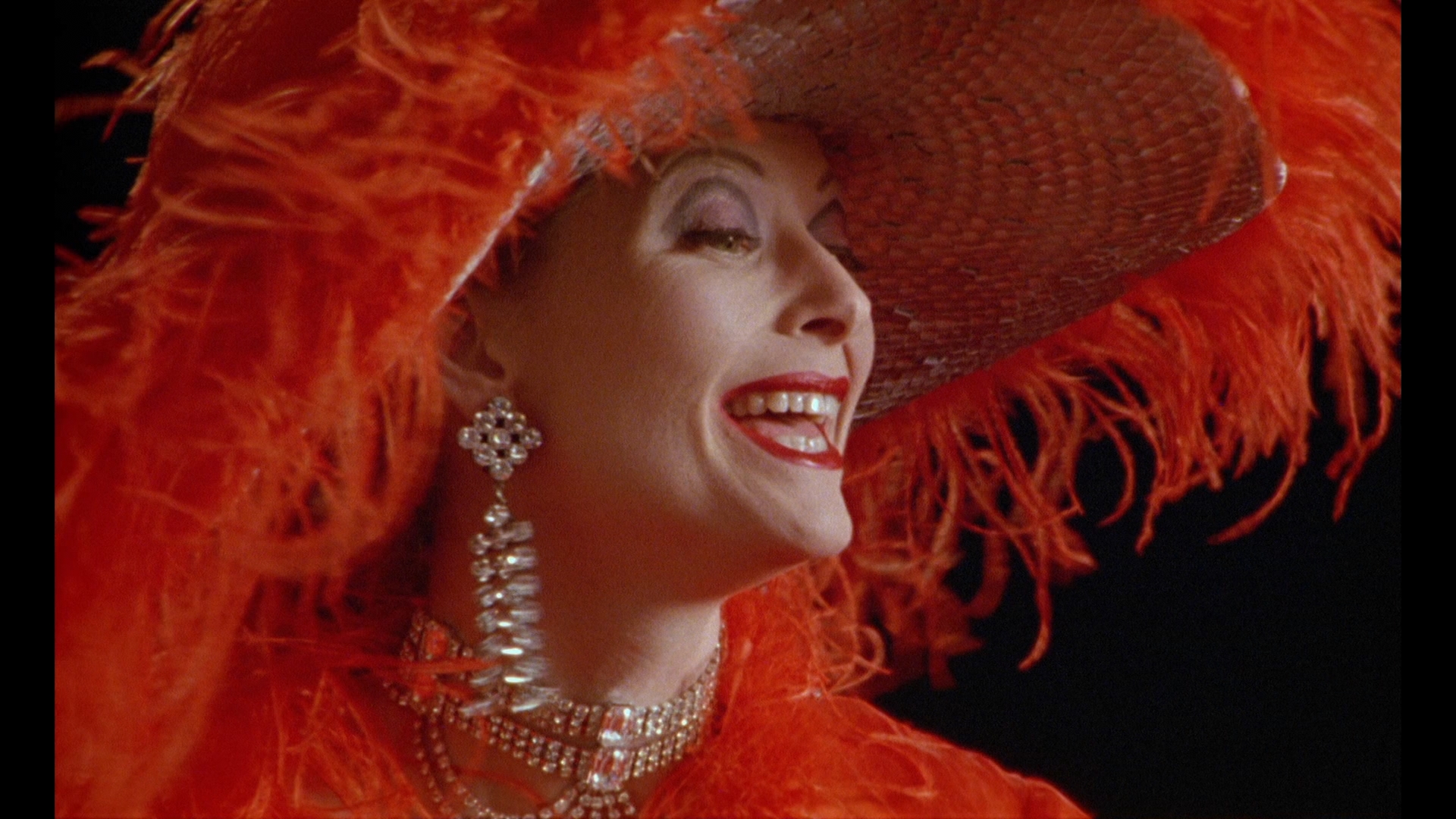
 life was always integrated into his creative process like an ongoing conversation. Producer Tariq Ali (9m27s) is quite funny as he explains how the film came about as part of that philosophy series and was intended to shock his fans with "no bums and willies!," and the impact of everyone knowing that
life was always integrated into his creative process like an ongoing conversation. Producer Tariq Ali (9m27s) is quite funny as he explains how the film came about as part of that philosophy series and was intended to shock his fans with "no bums and willies!," and the impact of everyone knowing that 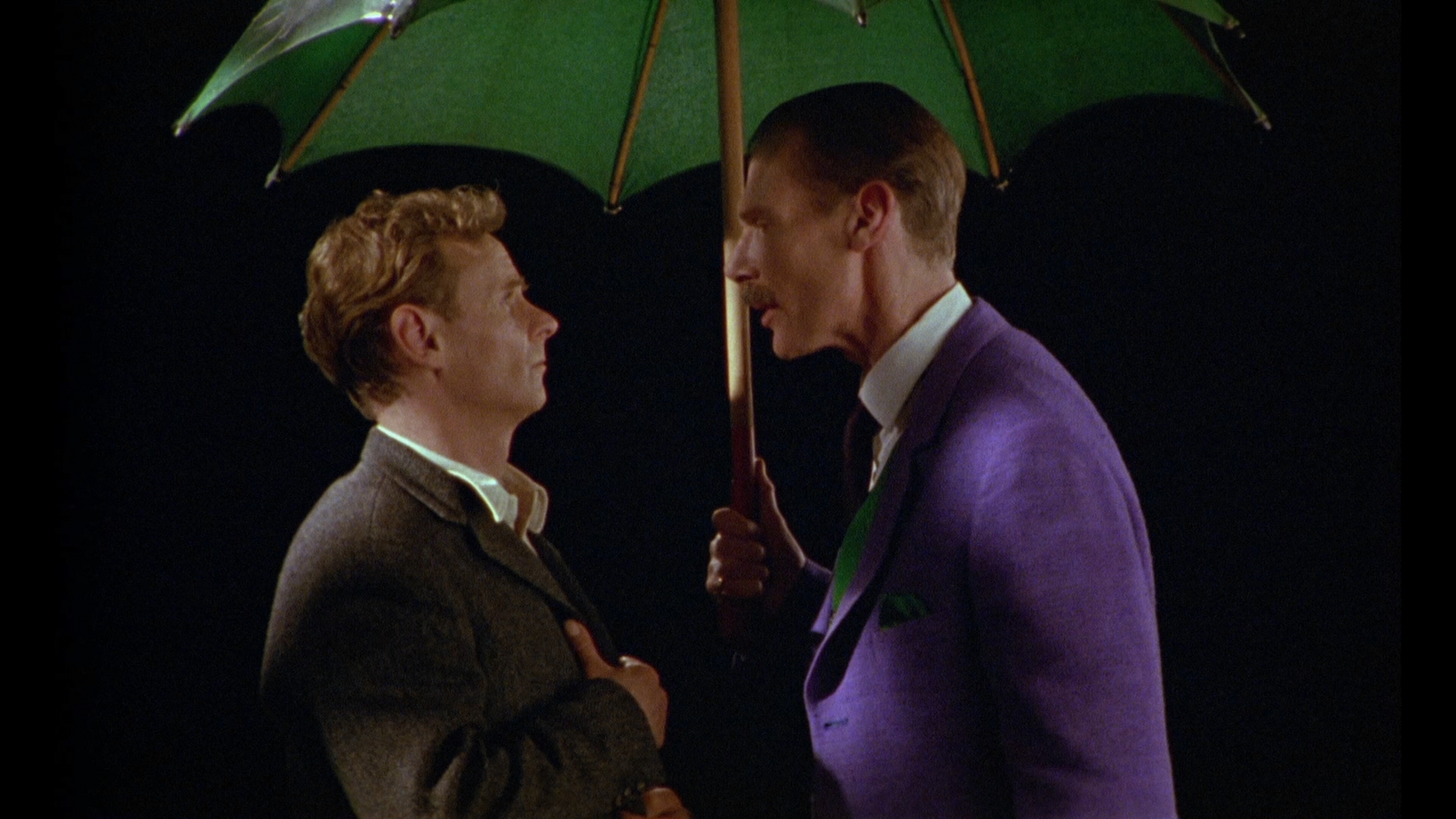 this would be Jarman's last traditional film (in terms of having actors on screen). A batch of behind-the-scenes footage (22m23s) is quite fun as well, especially watching Swinton flounce around in her spectacular outfit and a giddy Jarman directing from the sidelines. An intro to the film by Ian Christie (4m25s) is also included along with a newer Ali intro (6m49s) recorded in 2014 for Jarman season, and Turner's back with "Jarmanalia" (17m26s), a free-form interview about Jarman's relationship to music and how it affected the tone of his work. "Films Made by a Painter" (5m38s) brings back Mackay to discuss some of the aesthetic choices Jarman made like the number of sequences he plotted out in his films and the way his painterly approach can be found in many of his films, particularly (and most obviously) Caravaggio.
this would be Jarman's last traditional film (in terms of having actors on screen). A batch of behind-the-scenes footage (22m23s) is quite fun as well, especially watching Swinton flounce around in her spectacular outfit and a giddy Jarman directing from the sidelines. An intro to the film by Ian Christie (4m25s) is also included along with a newer Ali intro (6m49s) recorded in 2014 for Jarman season, and Turner's back with "Jarmanalia" (17m26s), a free-form interview about Jarman's relationship to music and how it affected the tone of his work. "Films Made by a Painter" (5m38s) brings back Mackay to discuss some of the aesthetic choices Jarman made like the number of sequences he plotted out in his films and the way his painterly approach can be found in many of his films, particularly (and most obviously) Caravaggio.  and sound effects to reflect on his state of mind and the memories of his life before and during AIDS. It's a strangely placid and poignant (yet still inherently frightening) work with
and sound effects to reflect on his state of mind and the memories of his life before and during AIDS. It's a strangely placid and poignant (yet still inherently frightening) work with 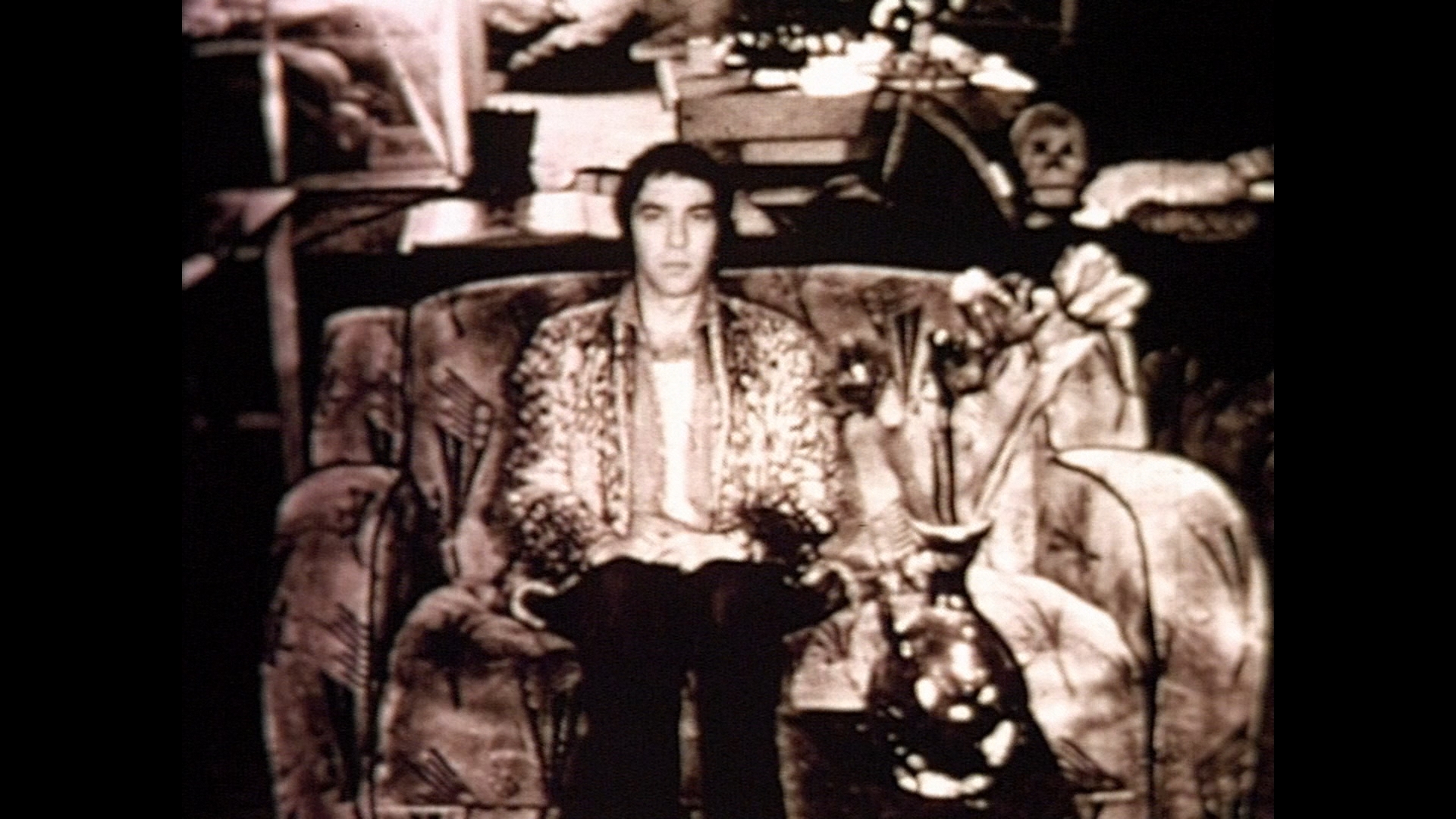 the focus on one color (the last one he could perceive before losing his sight) as an artistic farewell from a voice that was taken away far too soon. Then there's Glitterbug, a compilation of his unreleased Super 8 footage put together by his colleagues and friends with a score by Brian Eno. Released after his death and first aired as part of Arena on BBC Two, it's a stirring epitaph that includes music performance, location footage from Sebastiane, and several familiar faces (most memorably Swinton) to create a lovely little mosaic. Both films are combined on the final Blu-ray here, and while either one in HD may sound perverse on the face of it, you can't really imagine a Jarman set being satisfying in any form without them to close it out. The London International Film School's "21st Century Nuns" (10m7s) is a goofy little doc about an order of gay male nuns, The Sisters of Perpetual Indulgence, founded in San Francisco and now an actual global organization. Jarman makes a fun appearance in this, and it would even be worth watching otherwise. 2009's "Delphinium: A Childhood Portrait of Derek Jarman"(12m40s) delivers exactly what it promises, a stylish dramatization of Jarman (played by Samuel Garfield) in his youth discovering his artistic and sexual awakening at boys' school along with his passions for painting and gardening. The final Mackay interview (14m38s) focuses on Blue and how its genesis actually
the focus on one color (the last one he could perceive before losing his sight) as an artistic farewell from a voice that was taken away far too soon. Then there's Glitterbug, a compilation of his unreleased Super 8 footage put together by his colleagues and friends with a score by Brian Eno. Released after his death and first aired as part of Arena on BBC Two, it's a stirring epitaph that includes music performance, location footage from Sebastiane, and several familiar faces (most memorably Swinton) to create a lovely little mosaic. Both films are combined on the final Blu-ray here, and while either one in HD may sound perverse on the face of it, you can't really imagine a Jarman set being satisfying in any form without them to close it out. The London International Film School's "21st Century Nuns" (10m7s) is a goofy little doc about an order of gay male nuns, The Sisters of Perpetual Indulgence, founded in San Francisco and now an actual global organization. Jarman makes a fun appearance in this, and it would even be worth watching otherwise. 2009's "Delphinium: A Childhood Portrait of Derek Jarman"(12m40s) delivers exactly what it promises, a stylish dramatization of Jarman (played by Samuel Garfield) in his youth discovering his artistic and sexual awakening at boys' school along with his passions for painting and gardening. The final Mackay interview (14m38s) focuses on Blue and how its genesis actually 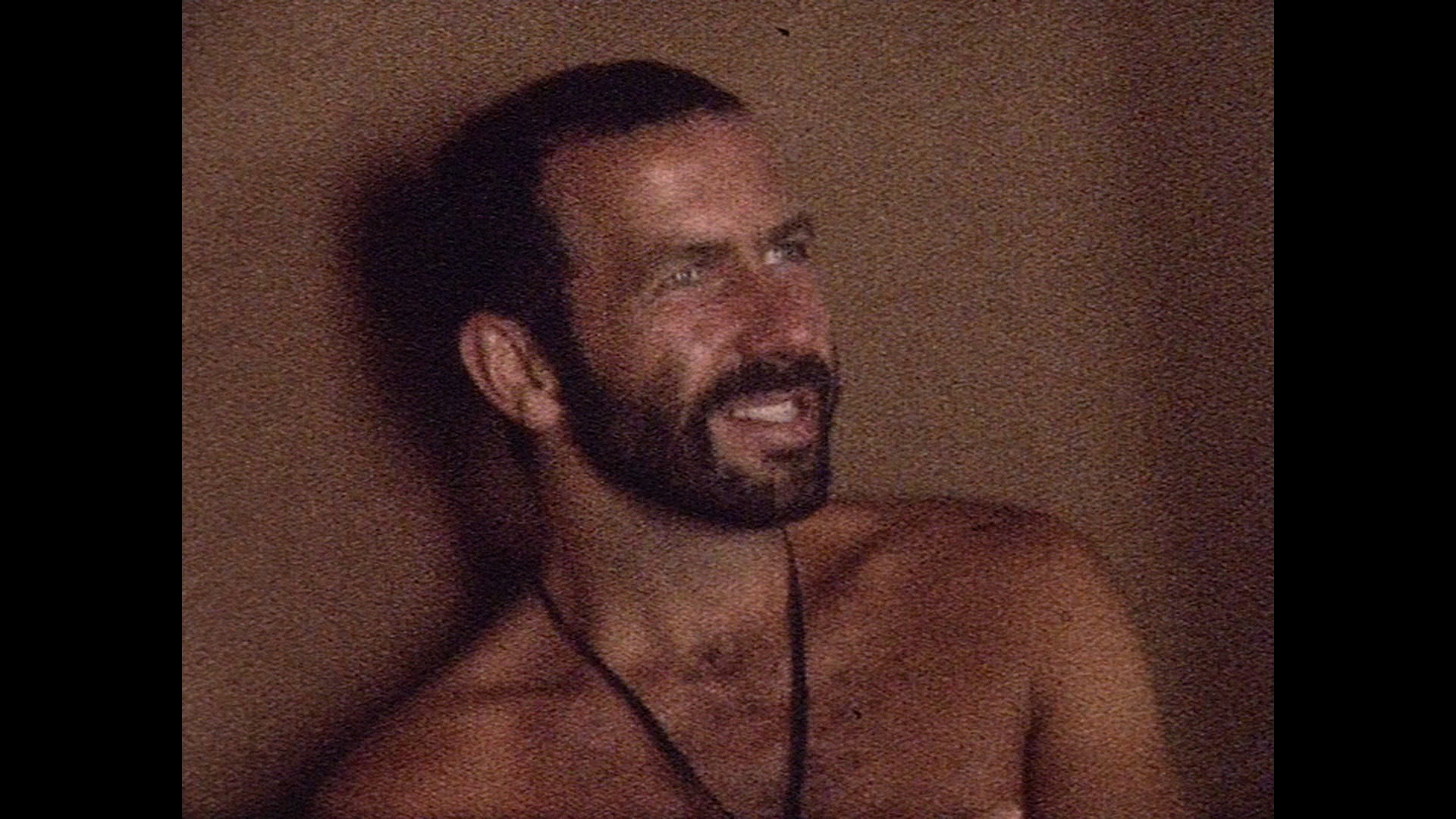 stretched
stretched 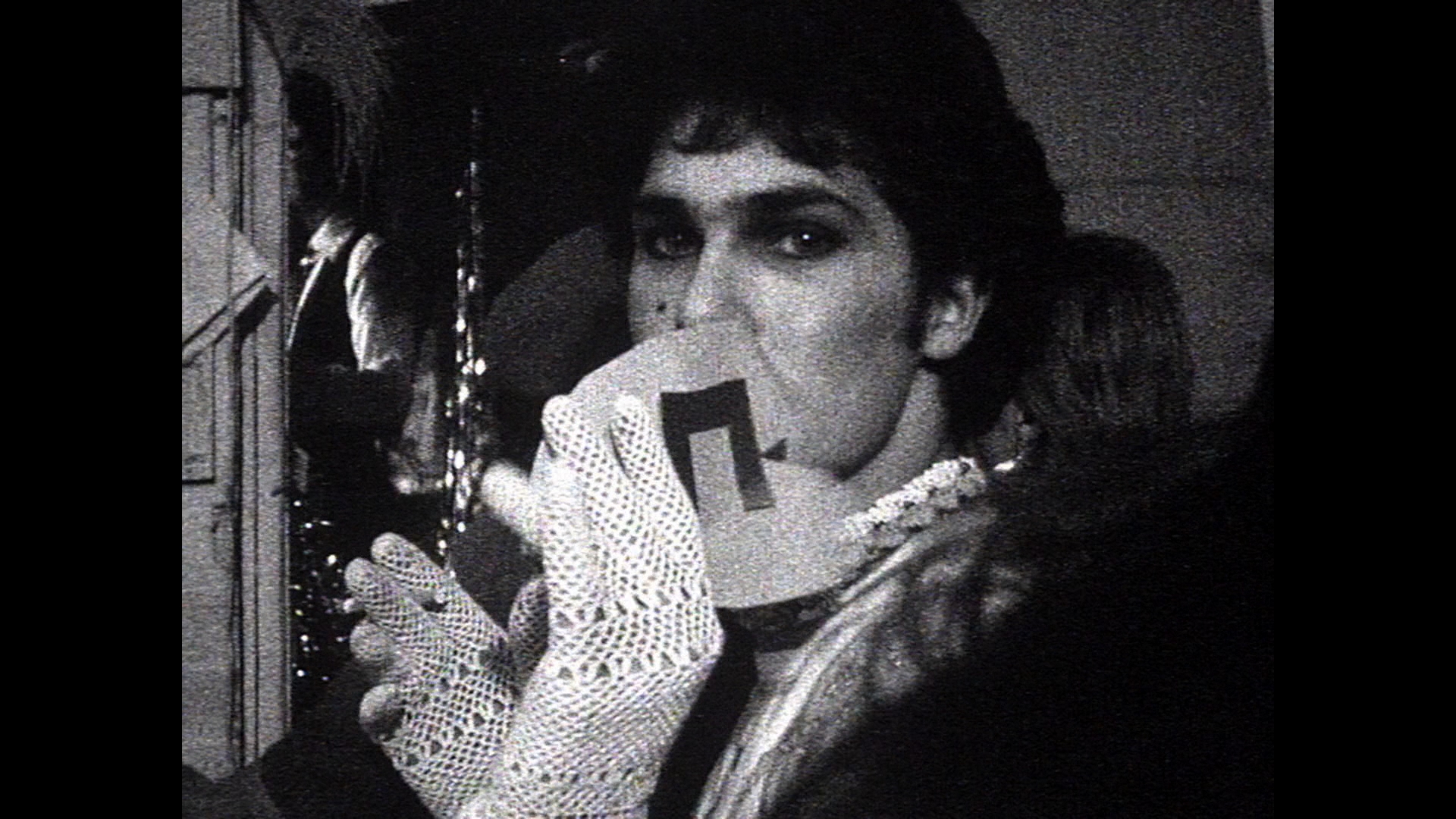 all the way back to The Last of England with inspiration coming from painter Yves Klein, while Turner (7m58s) and Lewis (13m34s) provide their own thoughts as well on that title in separate chats about what exactly defines a Jarman film (or even a film in general), the long gestation periods, and the process of assembling the dialogue and music tracks. Then Maybury shares his memories in "Hard to Imagine" (8m22s) touching on not only Blue but the political attacks on the gay community and the prophetic nature of Jarman's films, while Heslop goes into Jarman's final years in "After the Garden" (9m30s), which is quite a bit more lighthearted than you'd expect for the first half before turning quite poignant and wrenching at the end. Perhaps the most unexpected interview here is "Total Magic" (5m40s) with Hobbs tracing some of Jarman's use of illusionist techniques and his interest in the aesthetics of occult and magical imagery. Then "After Neutron" (8m17s) has Drysdale chatting about some of Jarman's unmade projects that fell by the wayside over the years, while Scarlett-Davis offers his own take on Jarman's final days and legacy in "The Best Mentor" (9m28s). Mackay is back again in "Glitterbug and Beyond" (7m25s) explaining how the project game together for television with Jarman unable to do any more original projects he had in mind, with Lewis following up in his own interview recollection (7m2s) covering the involvement of Eno and the parties involved in putting it together. Finally, the audio-only "Bliss" (39m15s) features the score and sound design of Blue separated as its own selected highlights reel. Each disc also contains an extensive gallery of photos, sketches, and other visual tidbits adding to the appreciation of this major visual artist.
all the way back to The Last of England with inspiration coming from painter Yves Klein, while Turner (7m58s) and Lewis (13m34s) provide their own thoughts as well on that title in separate chats about what exactly defines a Jarman film (or even a film in general), the long gestation periods, and the process of assembling the dialogue and music tracks. Then Maybury shares his memories in "Hard to Imagine" (8m22s) touching on not only Blue but the political attacks on the gay community and the prophetic nature of Jarman's films, while Heslop goes into Jarman's final years in "After the Garden" (9m30s), which is quite a bit more lighthearted than you'd expect for the first half before turning quite poignant and wrenching at the end. Perhaps the most unexpected interview here is "Total Magic" (5m40s) with Hobbs tracing some of Jarman's use of illusionist techniques and his interest in the aesthetics of occult and magical imagery. Then "After Neutron" (8m17s) has Drysdale chatting about some of Jarman's unmade projects that fell by the wayside over the years, while Scarlett-Davis offers his own take on Jarman's final days and legacy in "The Best Mentor" (9m28s). Mackay is back again in "Glitterbug and Beyond" (7m25s) explaining how the project game together for television with Jarman unable to do any more original projects he had in mind, with Lewis following up in his own interview recollection (7m2s) covering the involvement of Eno and the parties involved in putting it together. Finally, the audio-only "Bliss" (39m15s) features the score and sound design of Blue separated as its own selected highlights reel. Each disc also contains an extensive gallery of photos, sketches, and other visual tidbits adding to the appreciation of this major visual artist. ![]()